Kentucky is one of the smaller US states, but despite its size, more than 350 types of birds have been identified in Kentucky, making it a great place for amateur and experienced birders alike!
Included in this vast number are 24 different duck species, some that stay year-round and others that are here for the winter.
Whether you live in the state or are just visiting, you can enjoy the challenge of finding and identifying the different ducks that live here, so keep reading below to learn how to find them!
Three Basic Kinds of Ducks: Dabblers, Divers, & Sea
Most ducks can be divided into one of two categories: either a Dabbling Duck or a Diving Duck.
Dabbling ducks put their heads underwater to get food, but they rarely submerge themselves entirely. Their tails often point upward and bob up and down in the water.
Diving ducks, on the other hand, submerge themselves under the water to chase their prey or forage for aquatic plants. They will disappear for about 30 seconds at a time, although some ducks can stay underwater for much longer. In fact, Long-Tailed Ducks will dive as deep as 200 feet below the surface!
There is another category: Sea Ducks. However, sea ducks are basically just diving ducks who spend a lot of time in very deep waters, like the ocean.
In our list, we have identified each duck as a Dabbling Duck, a Diving Duck, or a Sea Duck. Kentucky has 14 diving ducks (including 8 sea ducks) and 9 dabbling ducks. But how can you identify one from the other? Let’s examine that question further below.
Learning to Identify Duck Species
Some ducks are easier to identify than others. In many species, males have more distinctive coloring, but that’s not a set-in-stone rule. There are also very plain males and flashy females.
Learning to differentiate between different kinds of ducks takes time and practice, but it’s definitely an attainable goal!
Just like learning to identify any other bird, these are the key things to look for:
- Size
- Shape/Silhouette
- Coloring/Patterns
- Behavior
- Habitat
- Range
- Calls/Songs/Vocalizations
Let’s move on to our list, which will help with many of these details!
American Black Duck (Dabbling Duck)
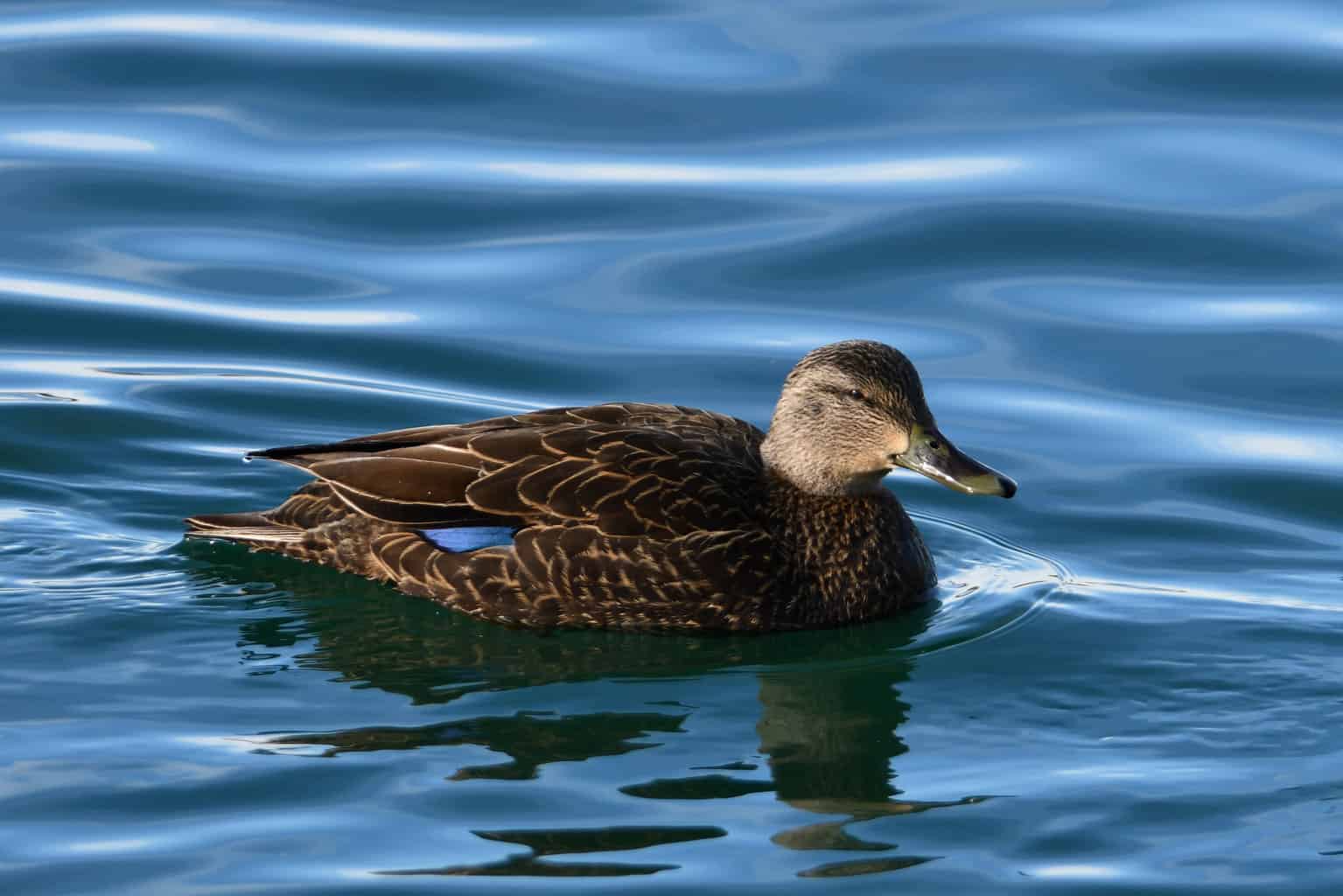
- Anas rubripes
- Length: 21.3-23.2 inches
- Weight: 25.4-57.9 ounces
- Wingspan: 34.6-37.4 inches
To identify a male American Black Duck, look for his dark brown body and violet-blue speculum, which is easiest to see when he is flying. Up close and on the water, he may look like a darkly colored female Mallard with a yellow bill.
Female American Black Ducks have a similar appearance, but they are lighter brown, and their bills are green instead of yellow.
American Black Ducks only show up on lists of ducks in eastern states and eastern Canadian provinces. They breed almost exclusively in Canada and New England, and they spend the winter in New England, the Midwest, and the Southeast.
These ducks choose wooded habitats and are threatened by deforestation and habitat loss.
American Black Ducks are plentiful winter residents of Kentucky. Their popularity with duck hunters may be what makes them so skittish!
American Wigeon (Dabbling Duck)

- Mareca americana
- Length: Up to 14 inches
- Weight: About 2.25 pounds
- Wingspan: 34 inches
Female American Wigeons have a light brown body and a dappled gray head with a black-tipped blue bill. they also have dark eyes.
Males are dark brown with a distinctive white crown. They also have an iridescent green stripe that starts at their eyes and swoops backward to the back of their head. Their blue bills are also tipped in black.
American Wigeons are prevalent throughout North America, depending on the time of year. They spend the summer breeding season in Western Canada and the Western US, then migrate through the Midwest and New England to their winter habitats.
These ducks winter in the Pacific Coast, most of Mexico, the Southern US and Atlantic Coast, and parts of Central and South America.
Most of Kentucky only sees American Wigeons while they are migrating, but there are some that winter in the far southwestern corner of the state, typically in the Land Between the Lakes National Recreation Area.
Black Scoter (Sea Duck)
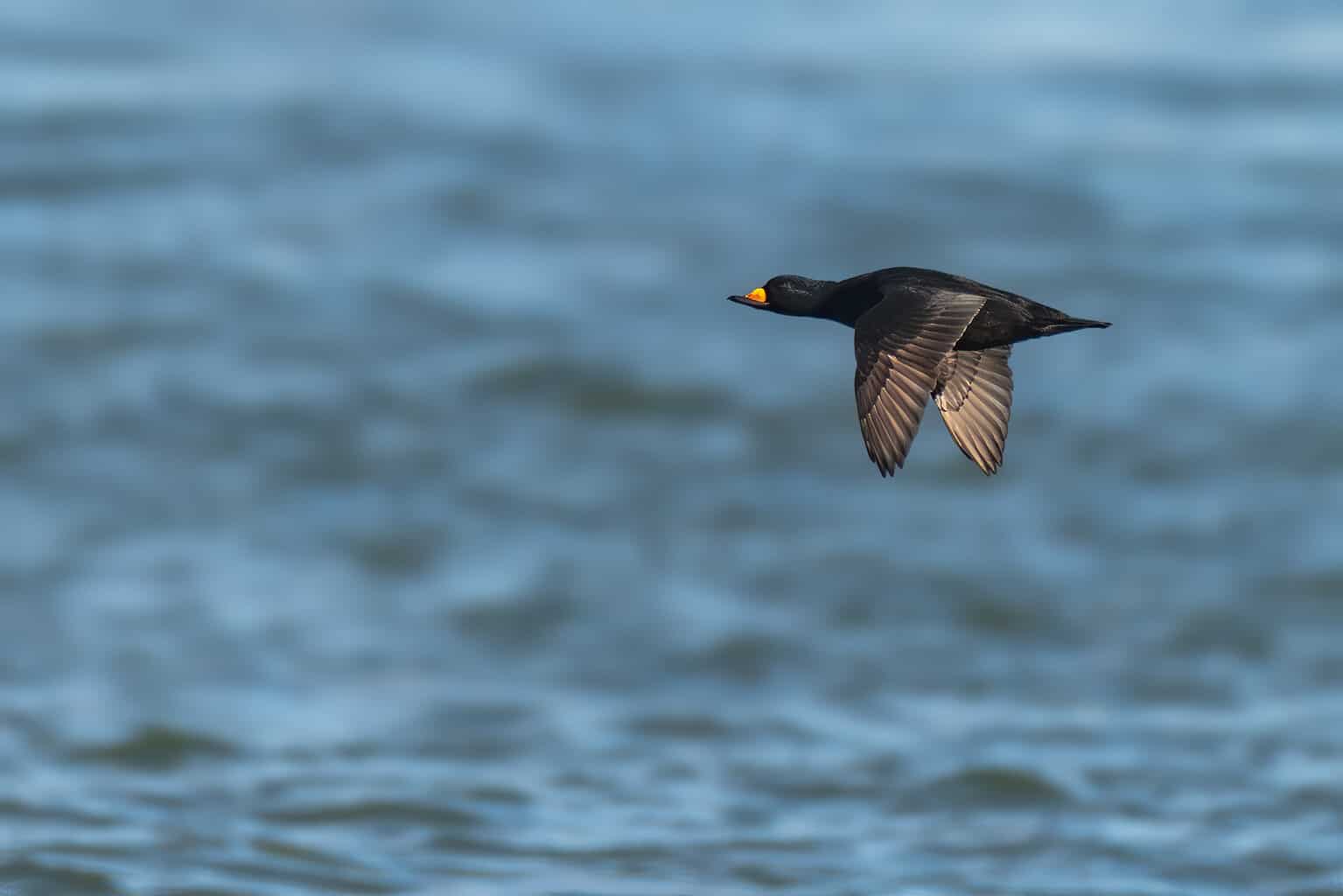
- Melanitta Americana
- Length: 127 – 21 in (43 – 53 cm)
- Weight: 387.4 oz (1088 g)
- Wingspan: 30 – 35 in (76 – 89 cm)
Scoters have unusually shaped bills compared to other waterfowl. The male Black Scoter has a large, bulbous orange shape at the base of his bill. Otherwise, his body is pretty much all black, including the rest of his bill and his legs.
The female’s bill is thick, but it does not have a bulbous shape. She is mottled in light and dark brown and has a pale gray cheek. Her crown is dark brown.
The Black Scoter only breeds in either Northern Alaska or Quebec. They spend their winters in North America’s coastal waters.
When they find their way to Kentucky, it is only an “accidental migrant.” This means that there aren’t enough sightings of Black Scoters in Kentucky to consider them to be a regular visitor during migration.
Blue-Winged Teal Duck (Dabbling Duck)
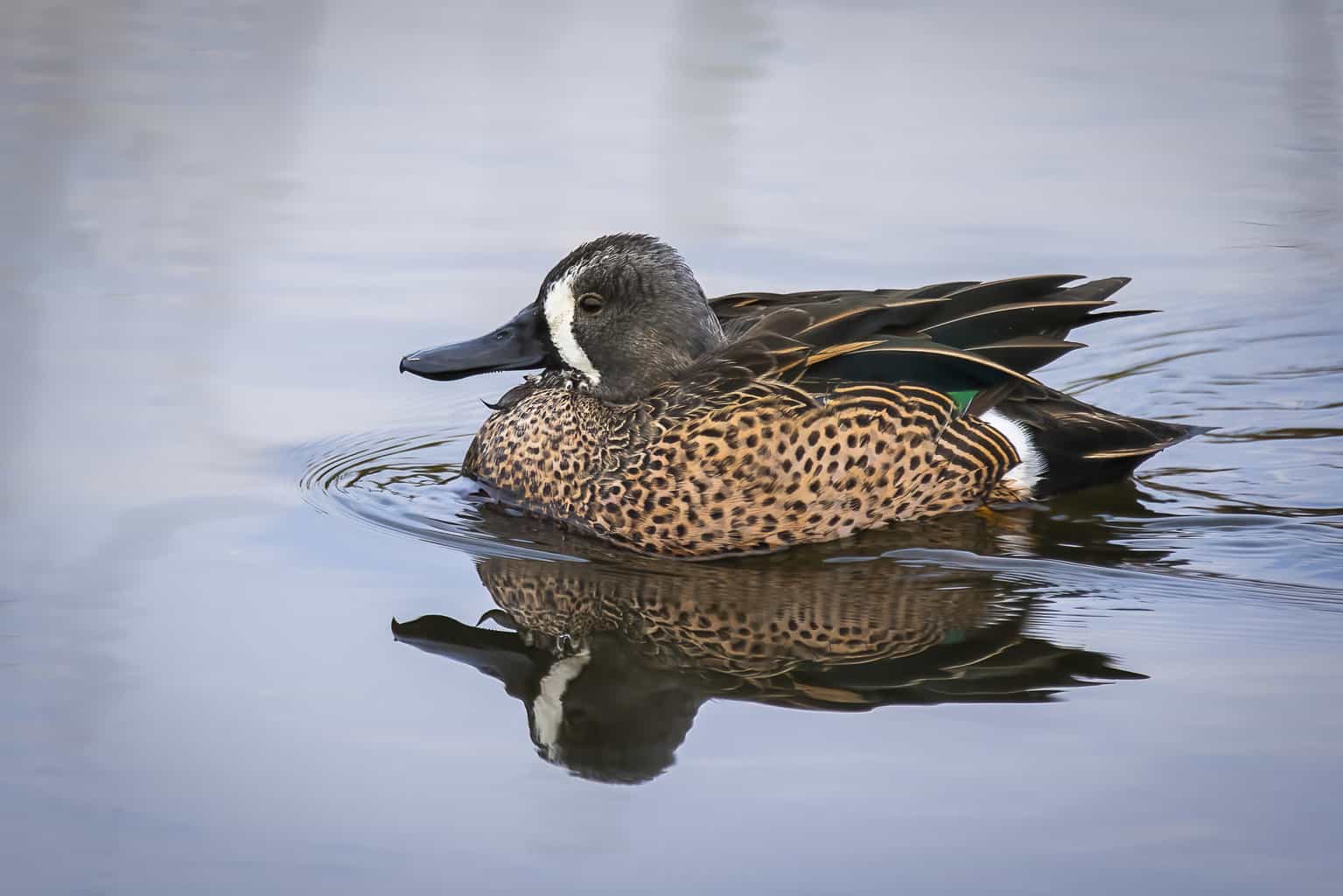
- Spatula discors
- Length: 15 – 17 in (38 – 43 cm)
- Weight: 19.18 oz (544 g)
- Wingspan: 23 -31 in (58 – 79 cm)
It’s easy to identify the male Blue-Winged Teal Duck by a specific facial marking. He has a crescent shape in white right in front of his eyes. Otherwise, his head is blueish-gray, and the rest of his body is a sort of dappled brown. He also has a blue patch on his shoulders and a green speculum, and his back is black.
Females, unfortunately, lack that distinctive crescent. Rather, they look like much smaller female Mallards in light and dark brown.
Blue-Winged Teal Ducks are almost exclusively migratory in most of Kentucky, although they may breed along the southern border, between Franklin and Monticello.
These tough little ducks have some hard things going for them. They have high mortality rates, likely because of their long and difficult migrations, and they are believed to be responsible for spreading avian influenza (bird flu) to poultry farms.
Bufflehead (Diving Duck)
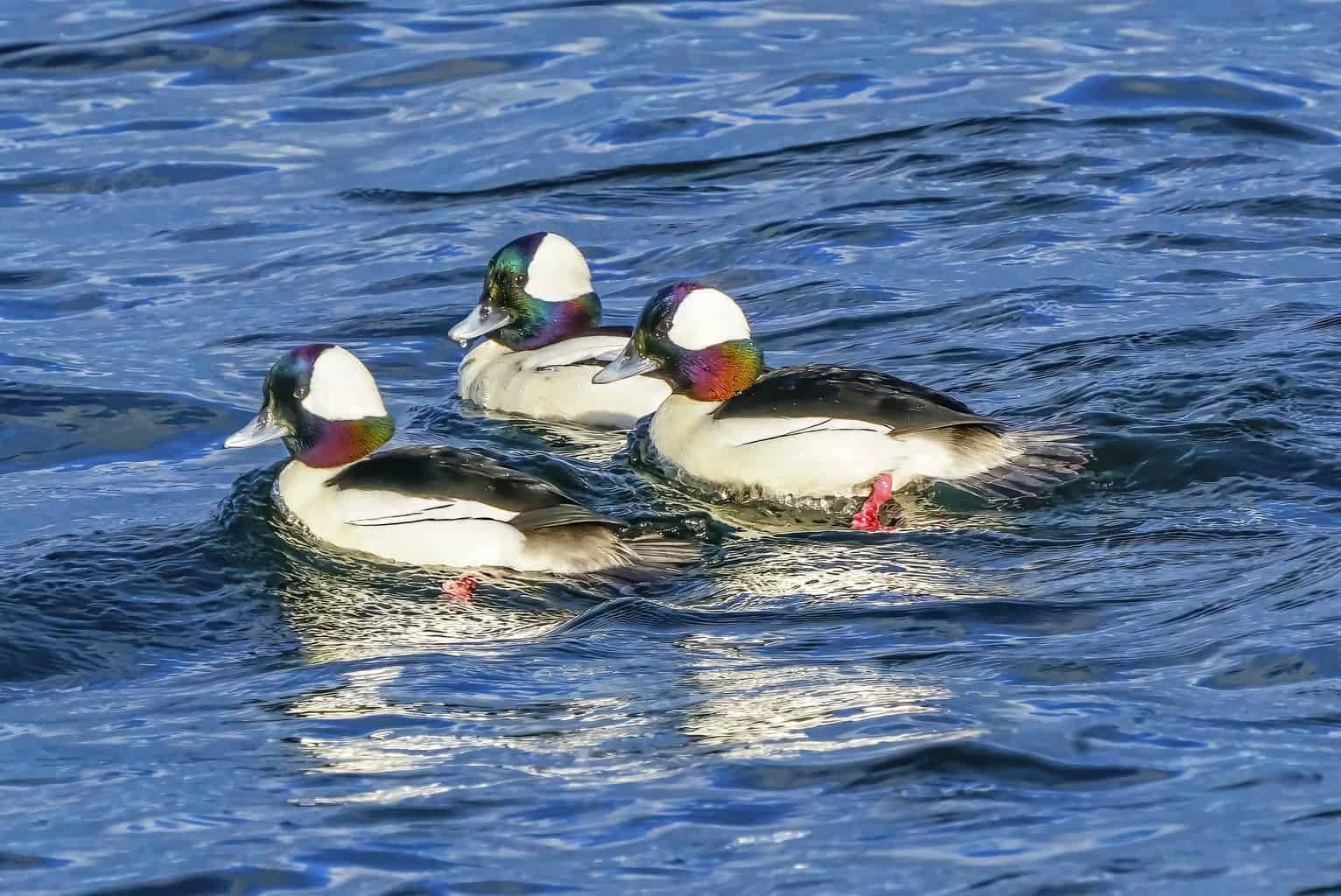
- Bucephala albeola
- Length: 13 – 16 in (33 – 41 cm)
- Weight: 21.16 oz (600 g)
- Wingspan: 21.6 in (55 cm)
Buffleheads of both sexes have rounded heads. Their name comes from the fact that they, like buffalo, have fluffy heads. Other than their heads, males and females look very different from each other, and are highly sexually dimorphic.
The male’s head appears to be color-blocked, with a large white fan shape in the middle of two iridescent green and purple areas. He has a black and white body.
The female is dark brown with a pale gray breast. Her head is dark brown, and she has a large cheek patch.
Along the eastern edge of Kentucky, Buffleheads are only found during their migration time. However, starting in Lexington and moving west, they are common winter residents.
Because Bufflheads are tree cavity dwellers, they are also prone to choosing nest boxes as their shelter. If you want to attract Bufflheads to your property, you can buy or build your own nesting box.
Canvasback (Diving Duck)
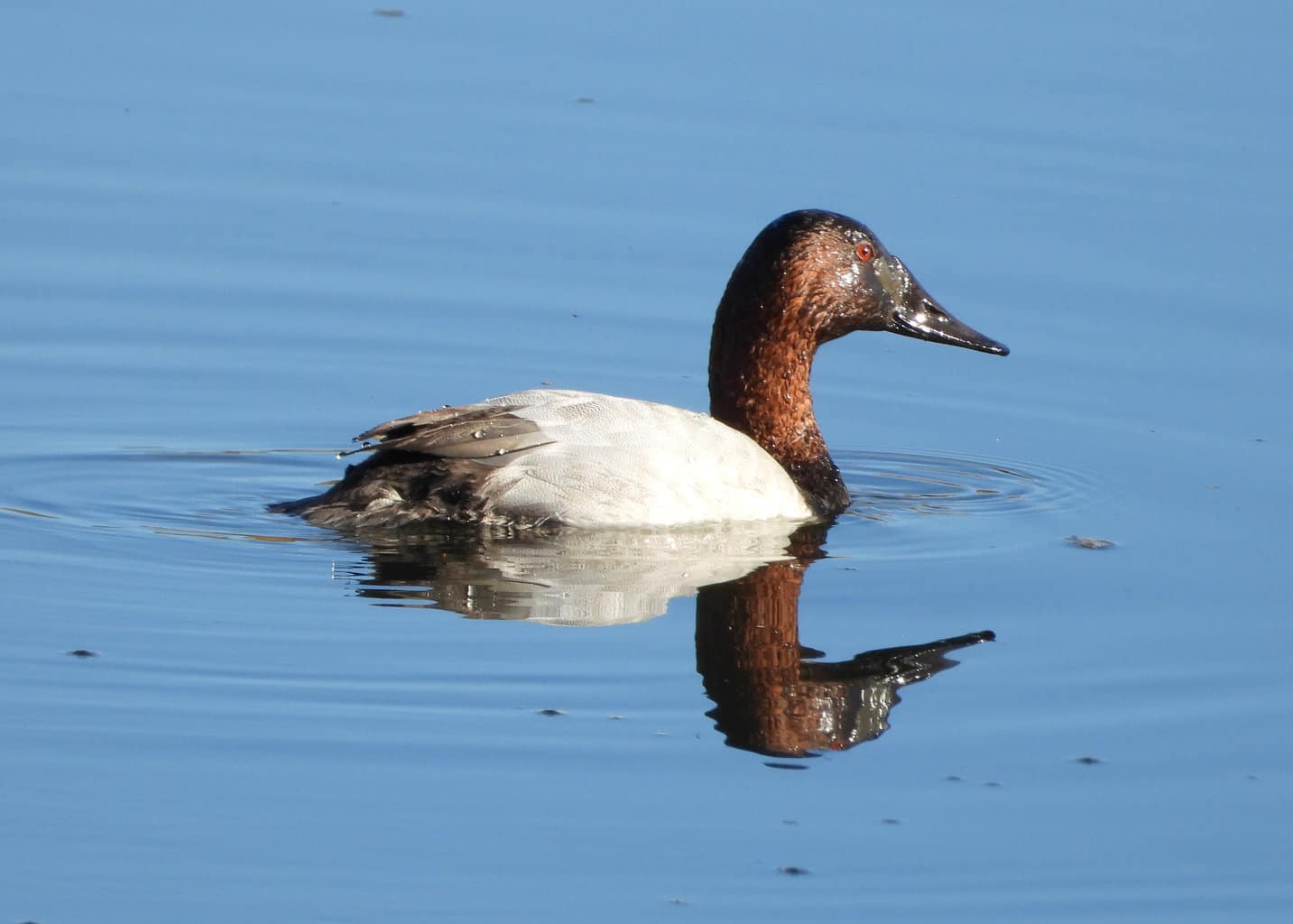
- Aythya valisineria
- Length: 19 – 24 in (48 – 61 cm)
- Weight: 58.48 oz (1657 g)
- Wingspan: 28 – 36 in (71 – 91 cm)
The Canvasback is North America’s largest diving duck.
The male’s forehead slopes dramatically forward. It’s dark reddish-brown, whereas his body is the color of a gray canvas. He has a bill that is thick and broad, and he has a black back and black tail feathers. His eyes, however, are red.
Females look like a more subtle version of the male, with more muted coloring, but the same basic pattern with red eyes.
Male and female Canvasbacks often winter separately from one another. This may be because males can withstand harsher winters than females, but may also be a mechanism for avoiding too much competition for the same food.
Canvasbacks are migratory in the eastern half of Kentucky and winter residents in the west. In both the winter and migratory areas, the Canvasback’s habitat includes both salt and freshwater sources, such as estuaries, rivers, lakes, and ponds.
Common Goldeneye (Sea Duck)
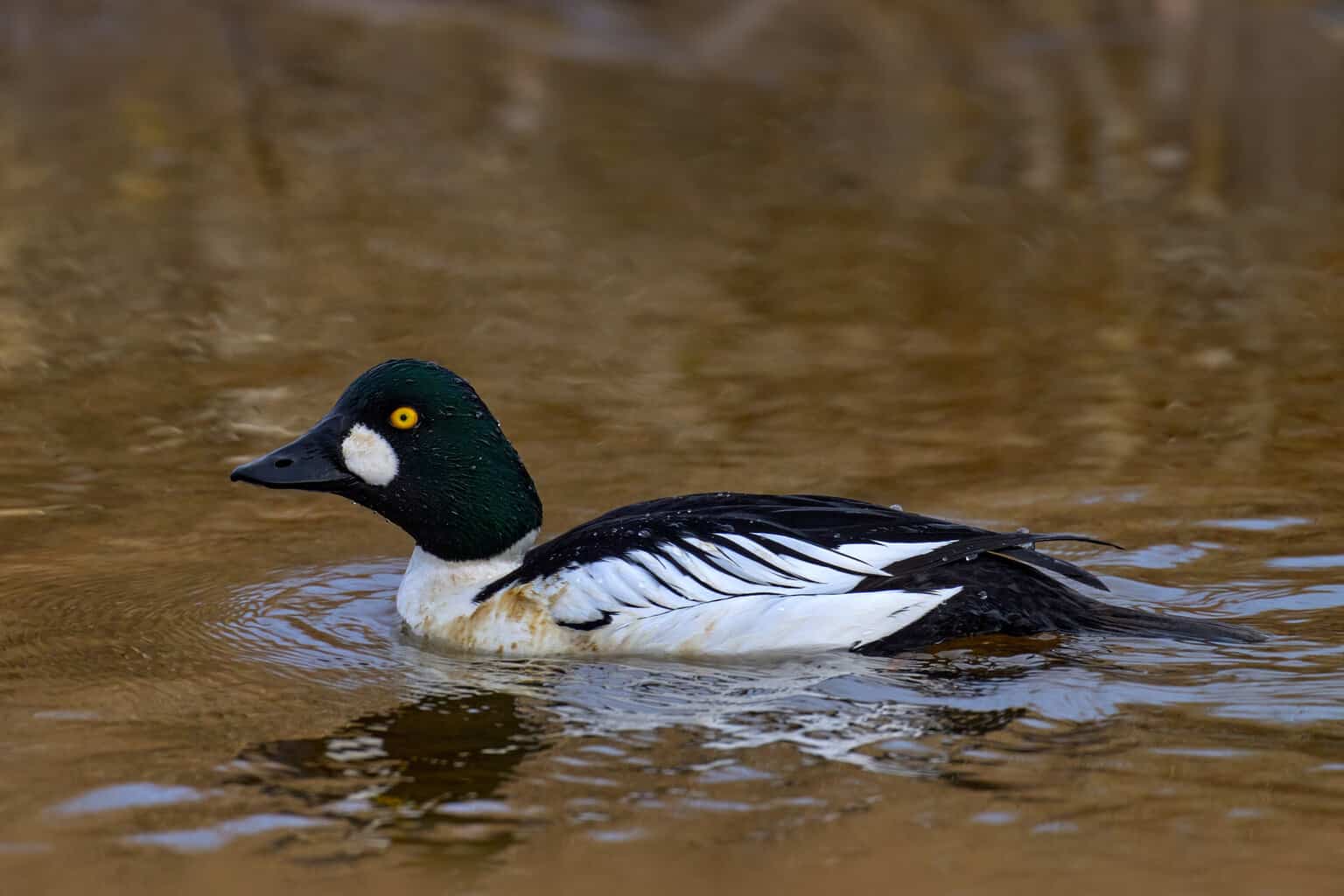
- Bucephala clangula
- Length: 16-20 inches
- Weight: Approximately 1.8 pounds
- Wingspan: 30.3-32.7 inches
Male and female Common Goldeneyes fittingly get their name from their bright, golden-yellow eyes.
Male Common Goldeneyes are black and white, but they have an iridescent green head (sort of like a Mallard), which is much more angular than other ducks. The male also has white wing patches and cheek patches.
Females are mostly brown with dark brown heads and yellow-tipped black bills.
Because Common Goldeneyes are aggressive — even with one another — females will often break into fights. This can cause their ducklings to scatter and then form new family groups, and fortunately, this doesn’t seem to have a negative effect on the ducks.
Common Goldeneyes are widespread throughout the US during the winter, including pretty much all of Kentucky, often in the state’s forested lakes and ponds.
Common Merganser (Sea Duck)
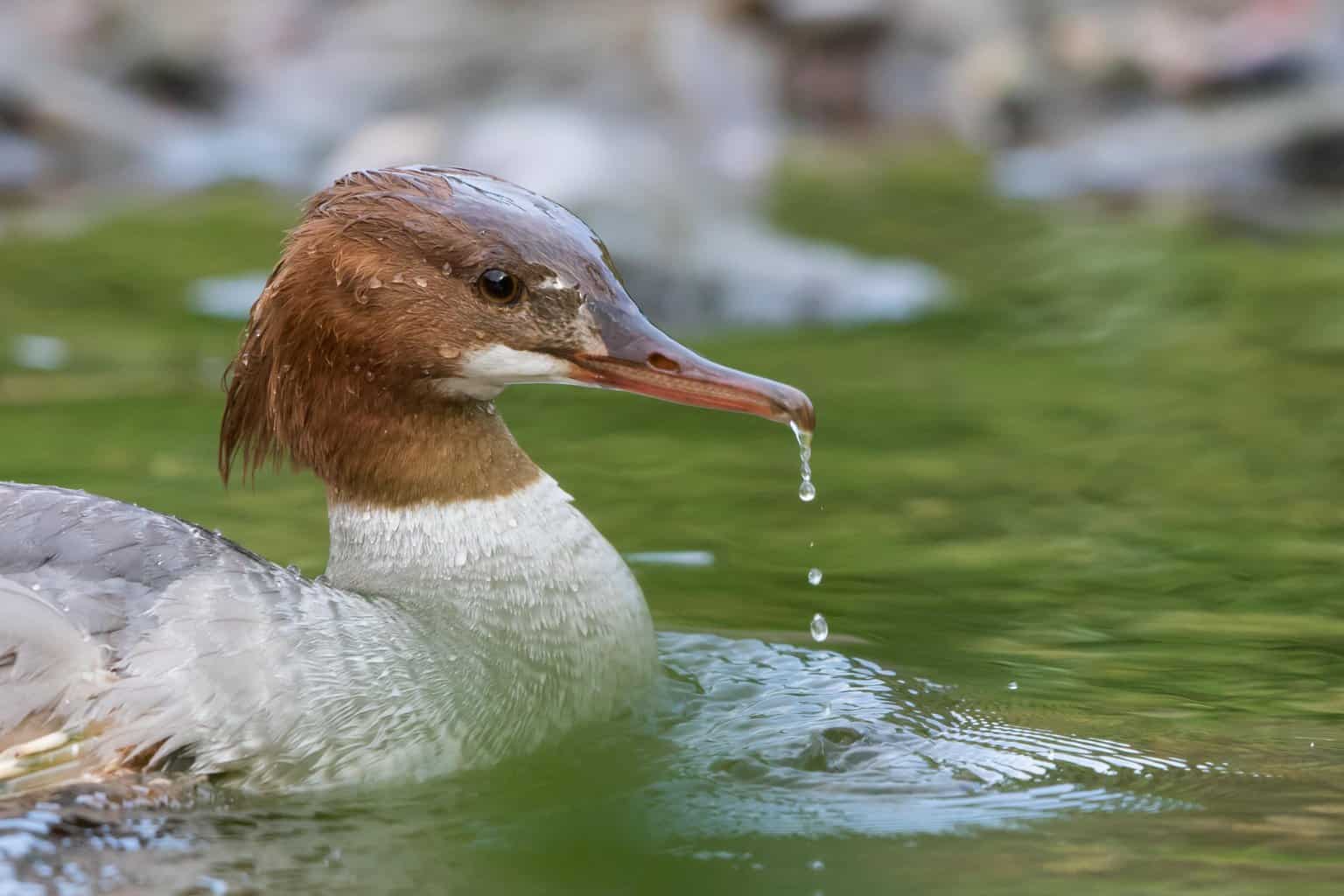
- Mergus merganser
- Length: 22 – 27 in (56 – 69 cm)
- Weight: 60.8 oz (1723 g)
- Wingspan: 31 – 37 in (79 – 94 cm)
Mergansers are flashy waterfowls with some distinctive features. The Common Merganser male, for example, has an iridescent green head and a long, bright red bill with serrated edges. He has black eyes, a black back, and a white belly.
The female is white-breasted with a gray belly and back. Her head and shaggy crest are dark reddish-brown.
Those serrated bills on both males and females are used to capture prey and rip up fish, crack into mollusks, and easily consume worms, frogs, and even small mammals.
Kentucky is right along the southern edge of Mergansers winter territory, meaning they can be found in the northern half of the state, but rarely beyond.
Gadwall (Dabbling Duck)
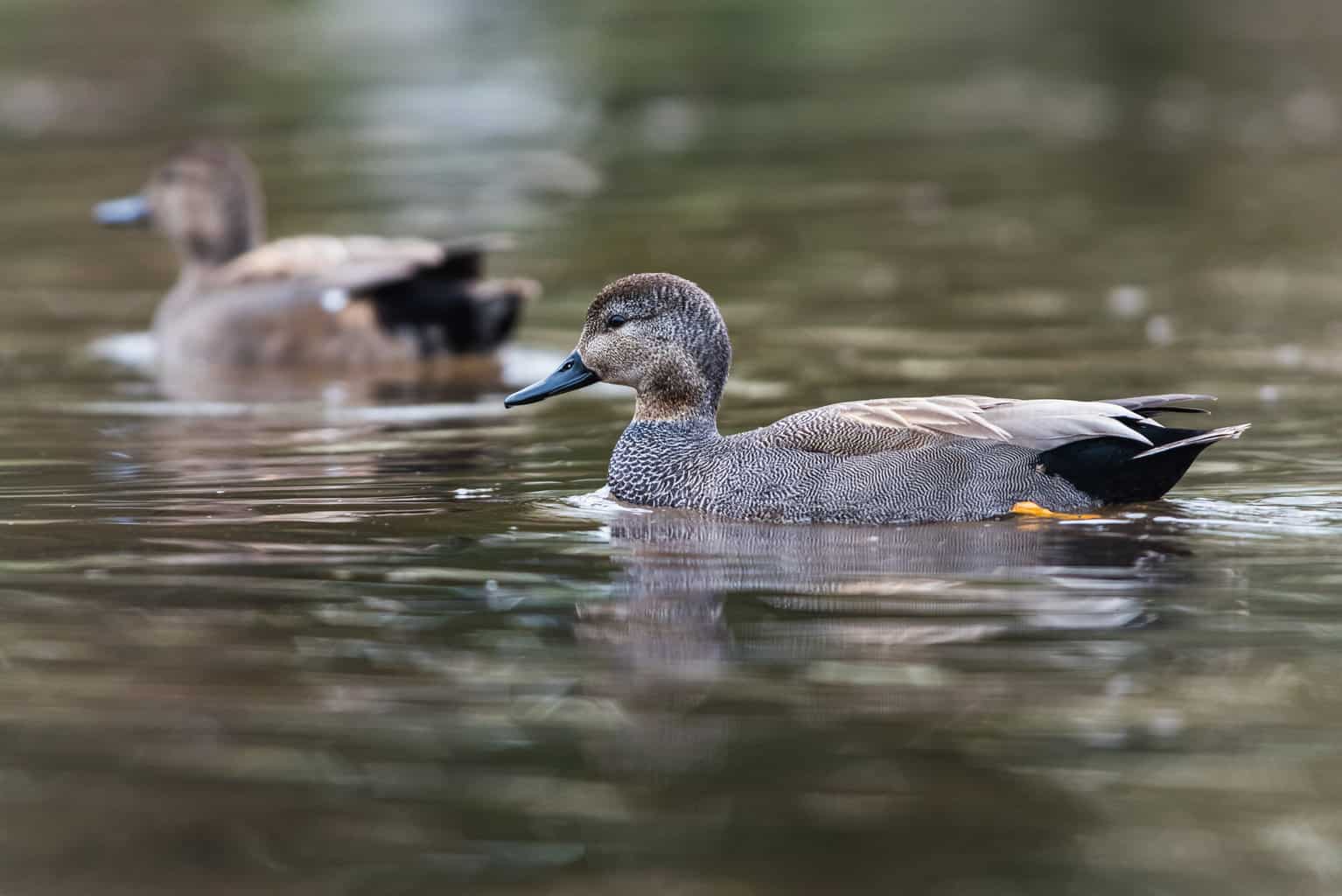
- Mareca strepera
- Length: 19 – 23 in (48 – 58 cm)
- Weight: 35.27 oz (1000 g)
- Wingspan: 31 – 36 in (79 – 91 cm)
Gadwalls are unassuming little ducks, but they are quite beautiful!
Male Gadwalls have a delicate, tiny scalloped pattern on their chest. They also have a black tail and a dappled, brownish-gray head.
Females are more patchy in their appearance. Their coloring ranges from dark to light brown. They have bright orange bills, which are different from the male’s black bill.
Both males and females have white markings on their wings. The male has tiny black scallops on his grayish chest. His tail feathers are black, and he has a brownish-gray dappled head.
Females, however, are patchy with dark and light brown coloring. The female’s bill is orange, which contrasts with the black bill of the male.
Gadwall males and females have white, blocky marks on their wings.
These are incredibly common ducks throughout North America, probably because they have such successful breeding results.
In most of Kentucky, they can be spotted during the winter. However, they are strictly migratory visitors along the eastern edge of the state, so you are unlikely to see them very far east of Lexington.
Greater Scaup (Diving Duck)
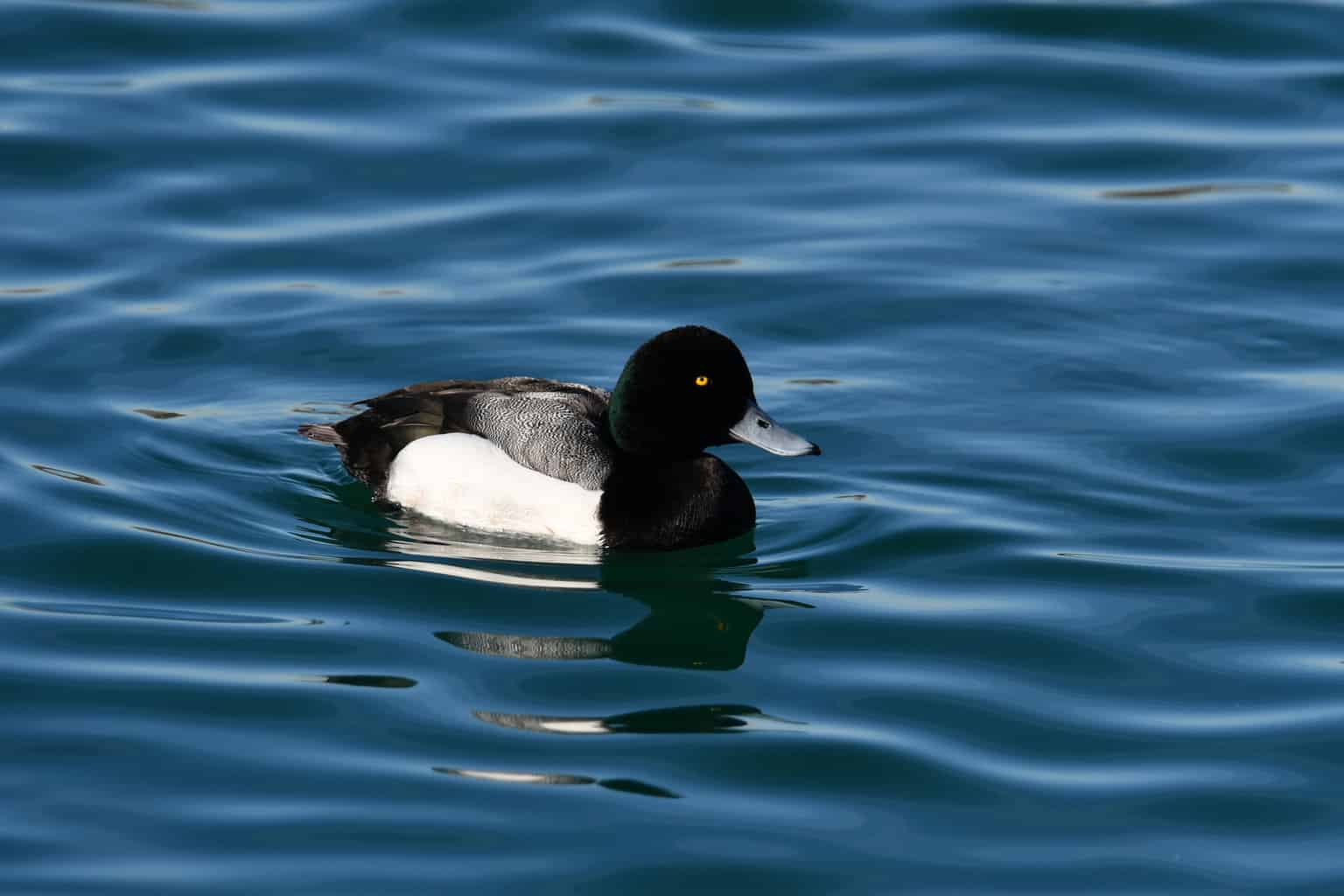
- Aythya marila
- Length: 15-22 inches
- Weight: 1.5-2.9 pounds
- Wingspan: 28-33 inches
There are two kinds of scaup, both of which can be found in Kentucky.
The male Greater Scaup is white with black and brown bars on his back. His head is iridescent green during the breeding season, but it fades significantly following the fall molt.
Females and non-breeding males look quite similar to one another, so it can be difficult to differentiate between them in the winter. They both have light brown bodies, dark brown heads, and minimal markings.
The female, however, has a thick, pale white-ish ring at the base of her bill.
Greater Scaups are winter residents of Kentucky’s eastern regions, specifically Jackson Purchase and Pennyroyal. Look for them in large freshwater lakes, such as Lake Barkley.
Green-Winged Teal Duck (Dabbling Duck)
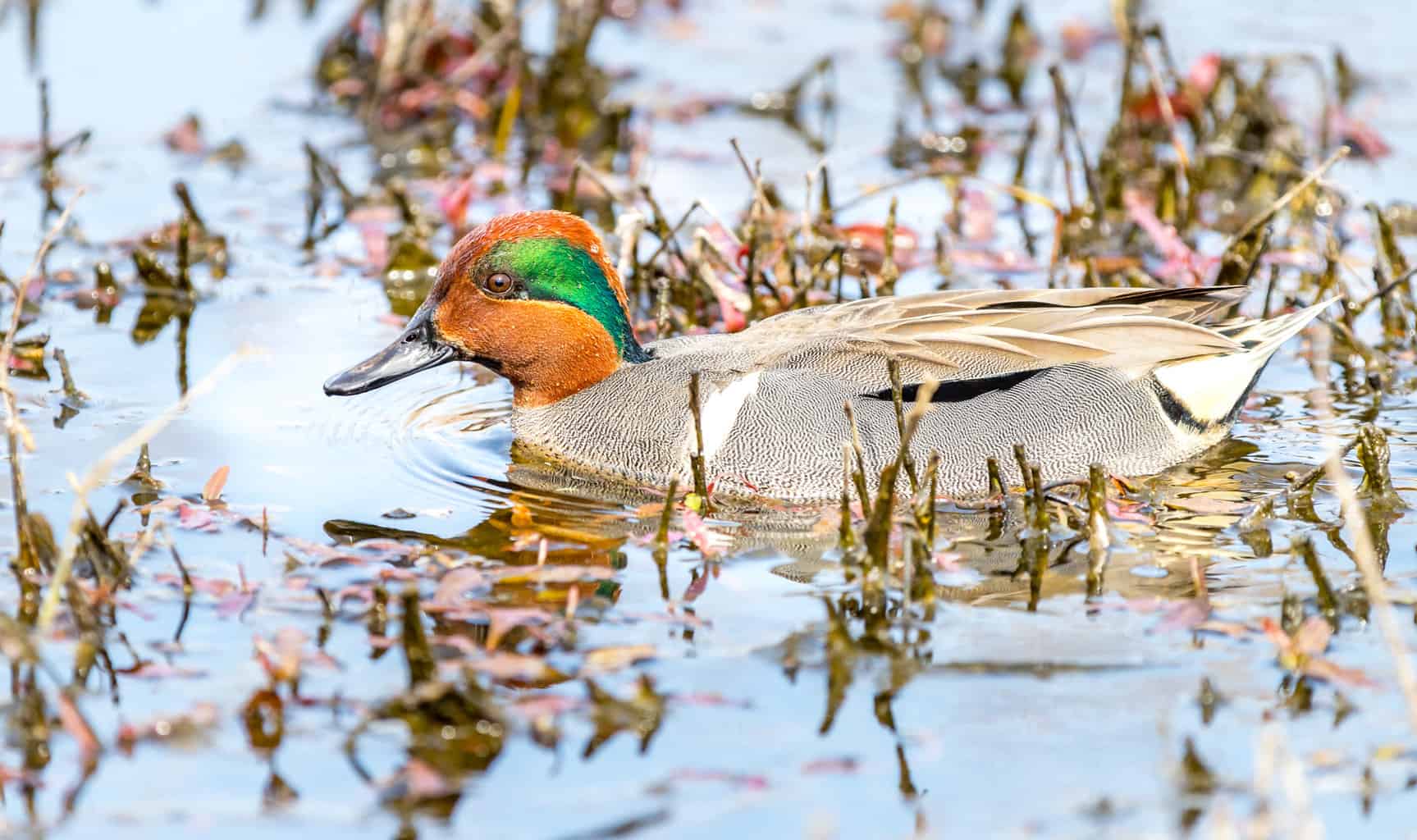
- Anas crecca
- Length: 12.2 – 15.3 in (31 – 39 cm)
- Weight: 4.9 – 17.6 oz (140 – 500 g)
- Wingspan: 20.5 – 23.2 in (52 – 59 cm)
I have a soft spot for the Green-Winged Teal Duck and its cute little face!
The male’s head is a soft-looking, chocolatey brown color, but he has a thick iridescent green stripe running across his eyes and swooping down.
The female Green-Winged Teal Duck varies from light to dark brown, and she has a yellow streak of color that runs along her tail.
These ducks get their name from their pretty green speculum.
Green-Winged Teal Ducks have the impressive ability to take off from water into flight, without any sort of running start. When they are startled, they will immediately burst into the air.
You’ll notice that the eastern edge of Kentucky has the most ducks on our list, likely because of the many lakes, ponds, and rivers.
Green-Winged Teal Ducks limit themselves to this area, namely Jackson Purchase and eastern Pennyroyal, because it features so many aspects of their ideal winter habitat: lots of aquatic grasses along shallow lakes and ponds.
Hooded Merganser (Sea Duck)
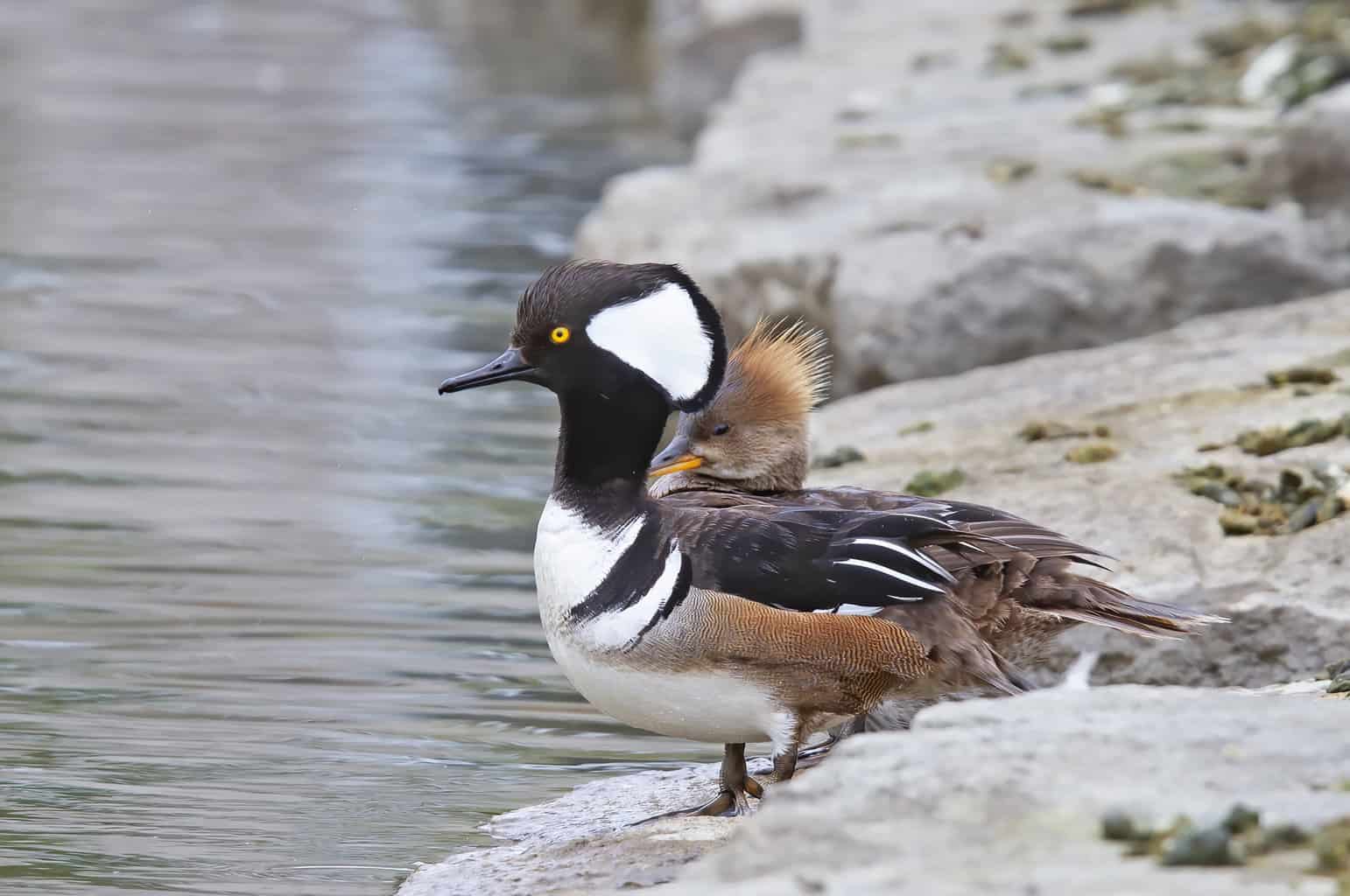
- Lophodytes cucullatus
- Length: 16 – 19 in (41 – 48 cm)
- Weight: 32.09 oz (909 g)
- Wingspan: 24 – 26 in (61 – 66 cm)
Hooded Mergansers look quite different than the other mergansers on our list. Instead of a long, shaggy crest that is green in males and reddish-brown in females, Hooded Mergansers have a large, fluffy head.
Hooded Merganser males have a black and white crest that they raise and lower, which changes the shape. The female’s crest is shaggier, but it still has a totally different silhouette than the other mergansers. Her crest is light cinnamon-brown.
The male has brown sides and a mostly black and white body. The female is brown, without noteworthy markings. Both male and female Hooded Mergansers have that noticeable serrated bill, but it’s quite a bit shorter than other mergansers. Their bills are mostly black, but the female may have some orange coloration, too.
Hooded Mergansers have a pretty great nickname: the Frog Duck. This comes from the fact that they sound a bit like a croaking pickerel frog when they call to one another.
They live year-round in Kentucky — one of the only ducks to do so! They nest in abandoned tree cavities and tree stumps. They breed and spend the winter along wooded streams and marshes.
These ducks are considered to be sea ducks because they are mergansers, but plenty of them never live in deep ocean waters.
Lesser Scaup (Diving Duck)
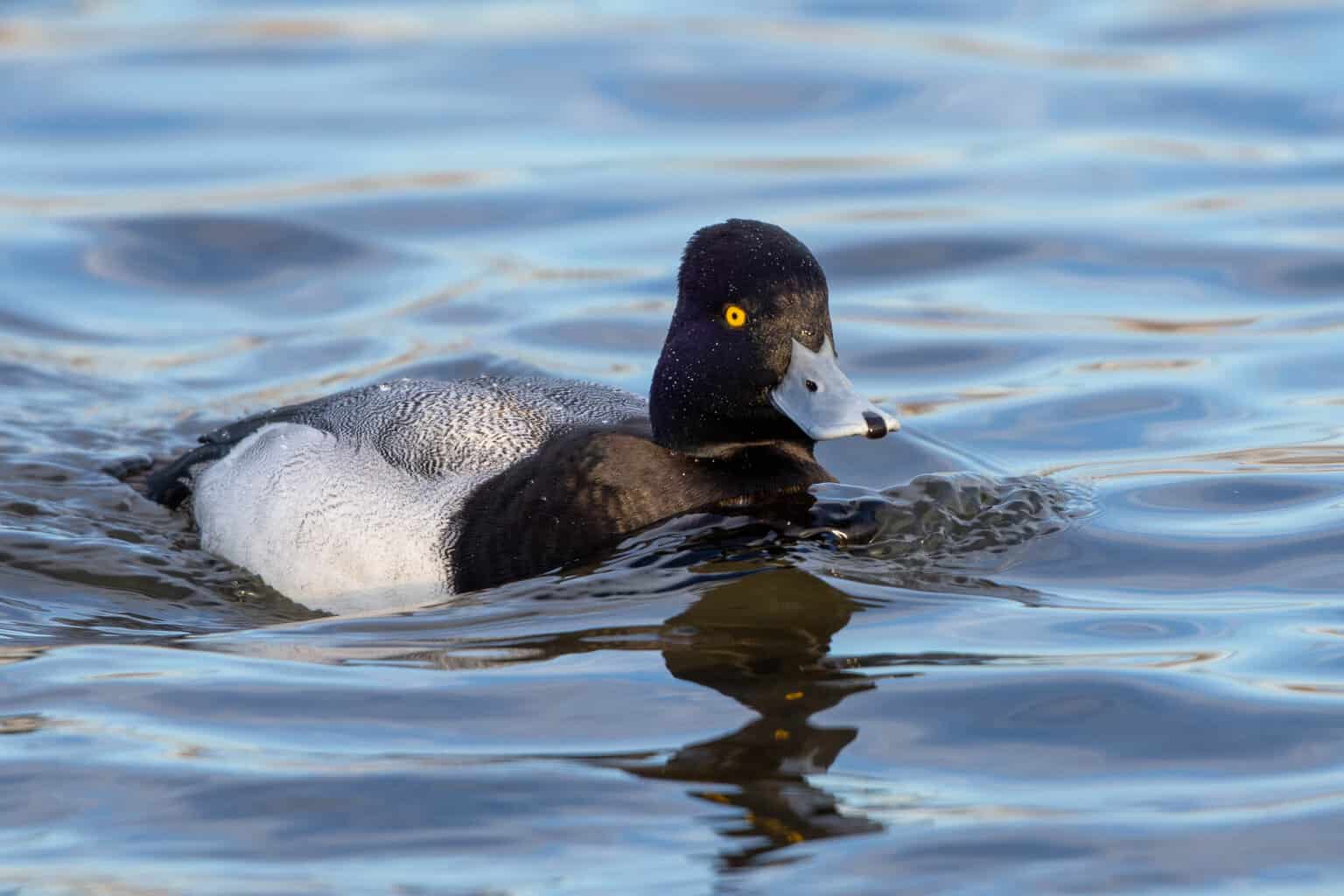
- Aythya affinis
- Length: 15 – 18 in (38 – 49 cm)
- Weight: 40.77 oz (1155 g)
- Wingspan: 24 – 33 in (61 – 84 cm)
Lesser Scaups are easy to confuse with the closely related Greater Scaup. However, there are some differences.
For instance, Lesser Scaup males have an iridescent greenish-purple head that is so dark that it looks black from far away (and sometimes in pictures.) He has gray and white barring all over most of his body.
The dark brown female is similar to the Greater Scaup, including the matching white face patch near the bill.
However, the best and easiest way to know which Scaup you’re looking at is to pay attention to the top of its head. The Lesser Scaup has a few feathers that look like stray hairs on the top of its head, while this tiny crest doesn’t exist on the Greater Scaup.
I also found many accounts of Lesser Scaup adults pretending to be dead in order to deter predators, but no such records of Greater Scaup doing the same.
Long-Tailed Duck (Sea Duck)
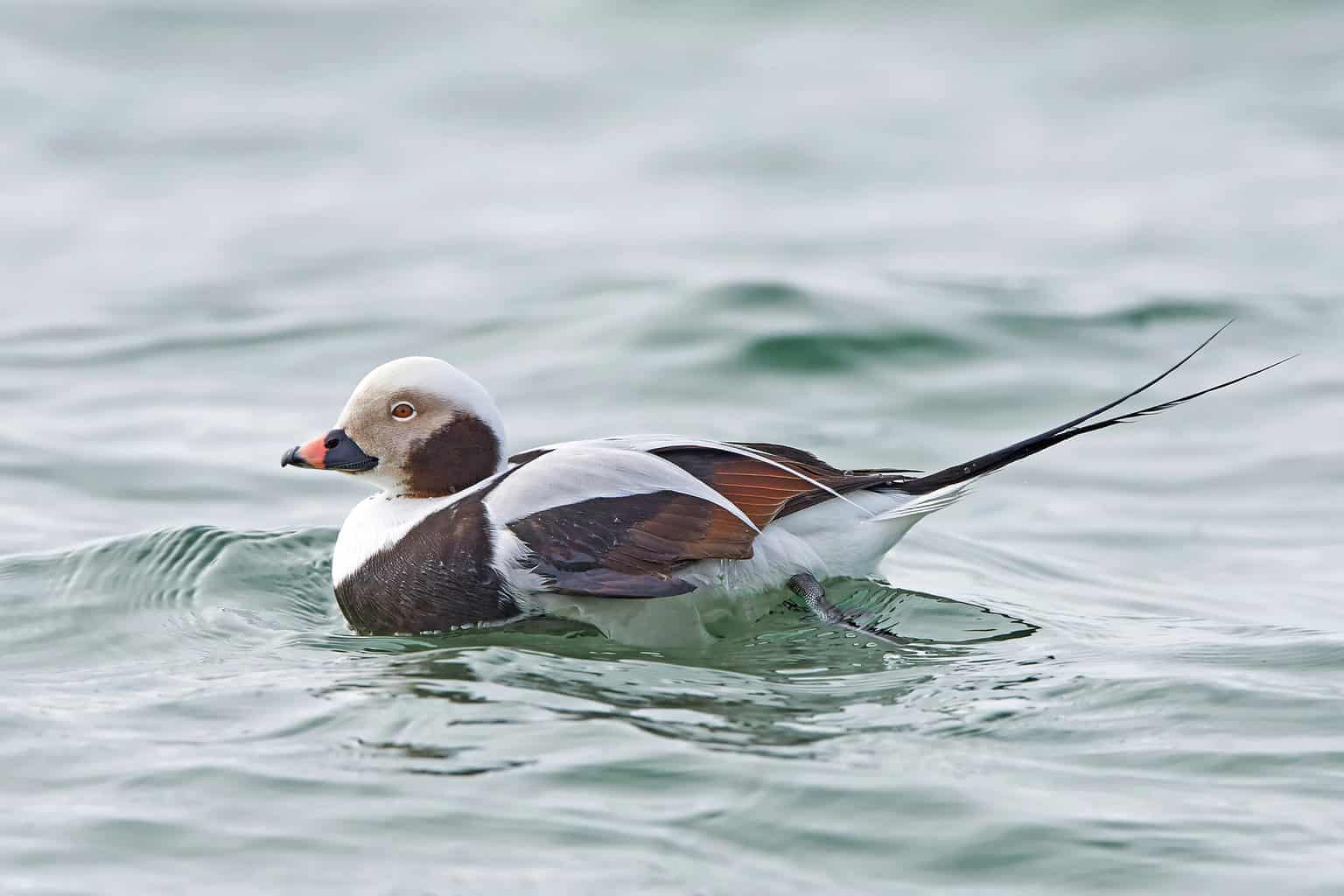
- Clangula hyemalis
- Length: 15 – 22 in (38 – 56 cm)
- Weight: 31.74 oz (900 g)
- Wingspan: 26 – 31 in (66 – 79 cm)
Long-Tailed Ducks are one of the most fascinating waterfowls on this list.
Males are mostly black and white, but their appearance reverses itself completely from breeding season to winter. It’s not just that their colors fade or they become more muted during the winter, but rather, the black and white areas of the duck completely reverse.
The male Long-Tailed Duck’s shoulders, forehead, back, crown, neck, and belly are all white. He has a gray eye mask, but the rest of him is black: breast, tail feathers, cheek patches, and wings.
Females are brown and white, and they experience the same color reversal: what is white turns brown, and what is brown turns white.
In addition to this unusual color change, Long-Tailed Ducks are also the deepest diving ducks in the world, diving up to 200 feet under the surface to forage for their food.
Their diet consists of mollusks, crustaceans, and fish, as well as some aquatic plants.
You will often find the Long-Tailed Duck included in lists of ducks in Kentucky, which is why we’re including it here.
However, it should be noted that there has only been one sighting of a Long-Tailed Duck in the state, back in 2011 in Allen County. If a Long-Tailed Duck makes its way to Kentucky, that would be a very rare occurrence indeed.
Therefore, rather than searching for this one in Kentucky, instead, I recommend looking for it when you are visiting the coasts.
Mallard Duck (Dabbling Duck)
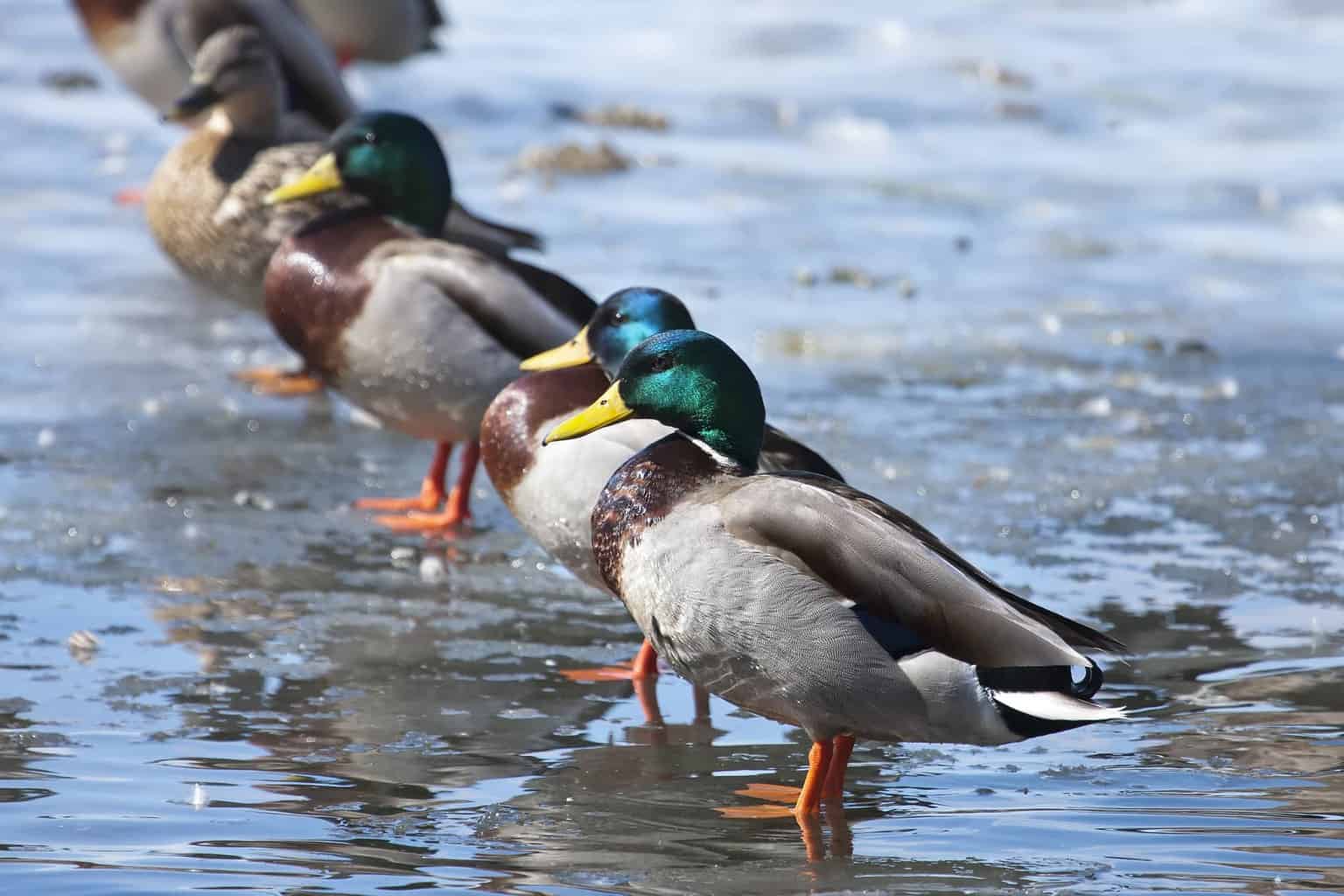
- Anas platyrhynchos
- Length: 19.7 – 25.6 in (50 – 65 cm)
- Weight: 35.3 – 45.9 oz (1000 – 1300 g)
- Wingspan: 32.3 – 37.4 in (82 – 95 cm)
If you ask the average person to identify ducks by moniker, my guess is that the Mallard is the one they are most likely to name. That’s because this stunning, plentiful duck is not just easy to identify from its markings, but also because it is a popular icon in home decor, furnishings, artwork, and even children’s toys.
- Squeeze, cuddle, repeat! Squishmallows are the softest, cutest plush toys around!
- Your new cuddle buddy awaits! Meet Avery the Mallard! Squishmallows have a style and personality all their own, encouraging fun...
- Snuggle up with the squishiest friend in town! These super soft, collectible plush toys make great cuddle companions! The squishy...
Last update on 2024-07-25 / Affiliate links / Images from Amazon Product Advertising API
Male Mallards have beautiful, iridescent green heads with white rings around their necks. His breast is dark brown, and his body is mostly gray. His speculum is baby blue, and his bill is bright yellow.
Females, however, are completely different in their appearance. They are speckled and streaked in various shades of brown. They have light brown heads and multi-colored bills (mostly orange, with black on the top and tip).
The male is iconic because of his stunning coloring and patterns. He has an iridescent green head and a gray body. There is a white ring around his neck, and he has a brown breast, a baby blue speculum, and a bright yellow bill.
Mallards are widespread globally, making them the world’s most common ducks. They are commonplace in Kentucky, especially in the winter. Some likely stay here year-round. They prefer large, slow-moving rivers and lakes, as well as ponds and flooded fields.
Northern Pintail (Dabbling Duck)
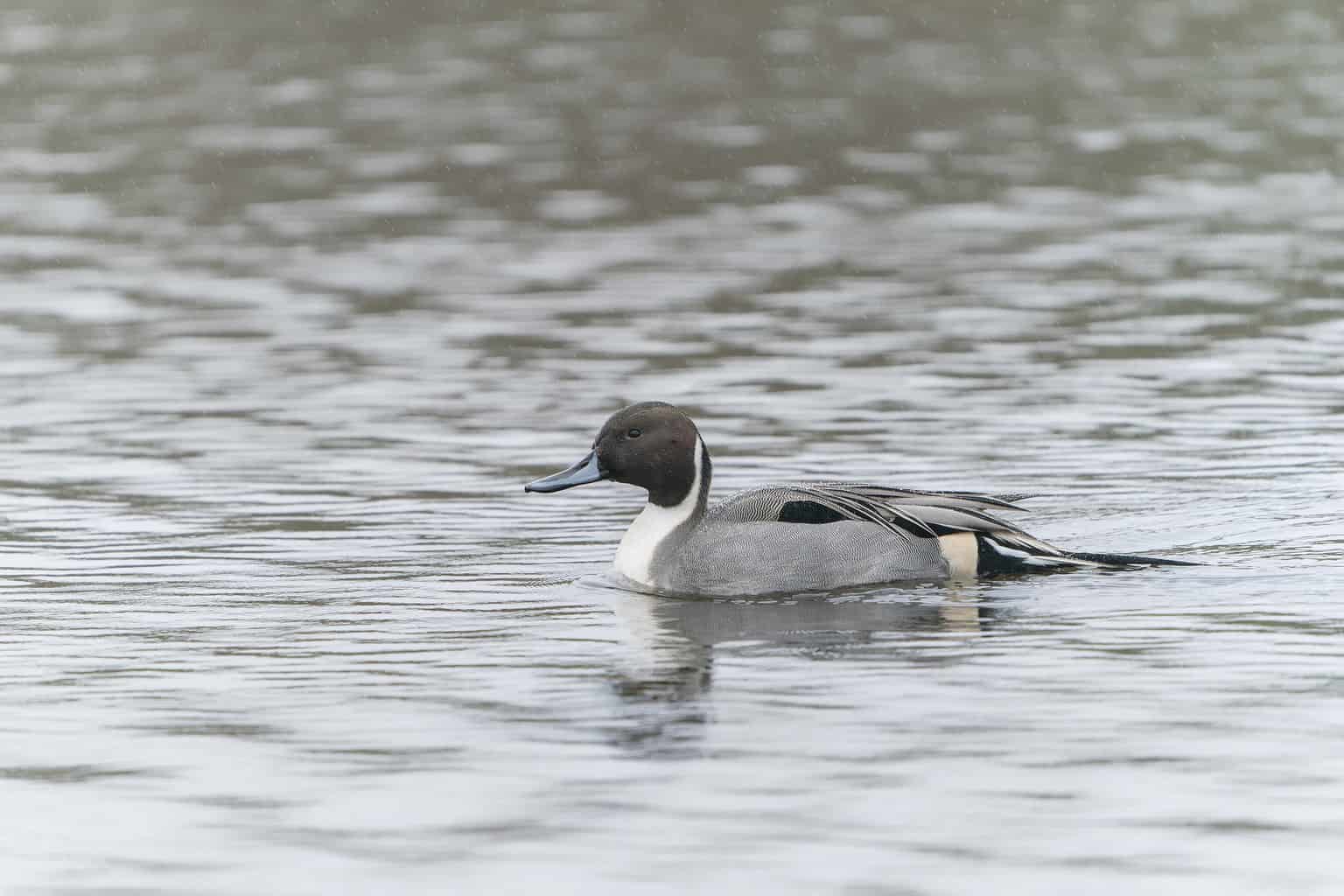
- Anas acuta
- Length: 20 – 26 in (51 – 66 cm)
- Weight: 36.33 oz (1030 g)
- Wingspan: 29 – 35 in (74 – 89 cm)
Northern Pintail males have long, pointed tails, especially in the summer. These long feathers fall off in the summer, but the tail is still pointier than many other kinds of ducks.
He has a gray body and a dark, chocolate-brown head. Along his neck is a long, white stripe.
The female’s tail is shorter, but also pointed. Her coloring is like small scales in light and dark brown.
Northern Pintails are fast flyers, clocking up to 48 miles per hour.
The majority of the state is simply a migratory pass-through for Northern Pintails, but some will spend the winter in the Jackson Purchase area.
Northern Shoveler (Dabbling Duck)
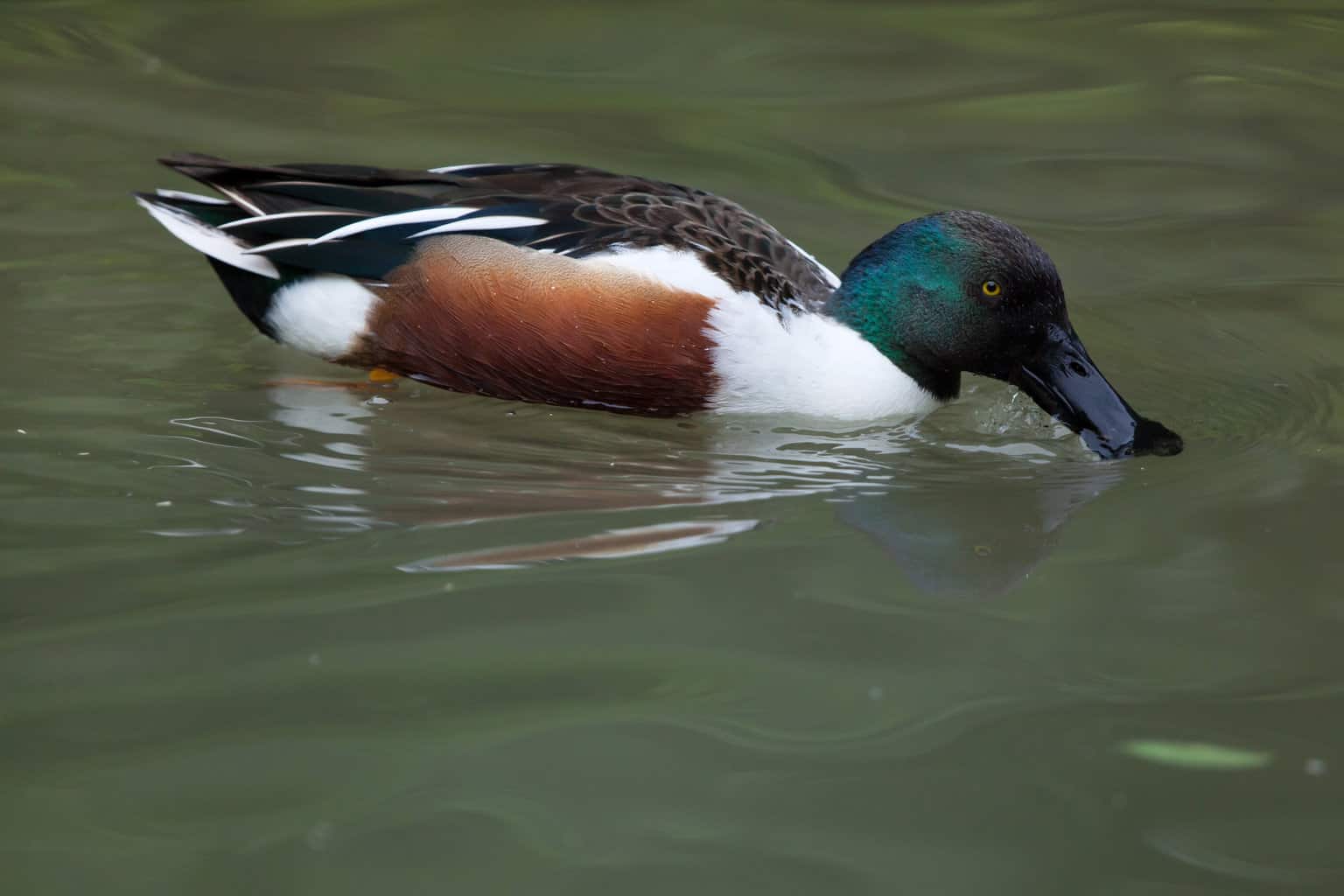
- Spatula clypeata
- Length: 17.3 – 20.1 in (44 – 51 cm)
- Weight: 14.1 – 28.9 oz (400 – 820 g)
- Wingspan: 27.2 – 33.1 in (69 – 84 cm)
At first glance, it could be possible to mix up a Northern Shoveler male with a Mallard male. After a closer look, however, there are major differences between them.
Although both Northern Shovelers and Mallard males have iridescent green heads, take a look at the bill.
The Northern Shoveler has a thick, black bill that is shaped somewhat like a spatula. He uses it to “shovel” up water and prey. Then, he lets the water strain out and keeps his meal!
The male has a gray body with brown wings and sides, while females have a coarse pattern in light and dark brown. Their heads are dark brown, and their bills and legs are orange.
Like so many other Kentucky ducks, you’ll find Northern Shovelers in the winter in Jackson Purchase. In the rest of the state, watch for them during their migration periods in the spring and fall. They may pass through on their way to their winter or summer habitats.
Because you’re not going to see a Northern Shoveler nest in Kentucky, you’ll miss out on one of the ickier duck habits that we’re aware of.
These ducks, when startled or threatened, will defecate on their eggs. This helps to deter predators. Northern Shoveler nests may be grosser than the average duck nest.
Red-Breasted Merganser (Sea Duck)
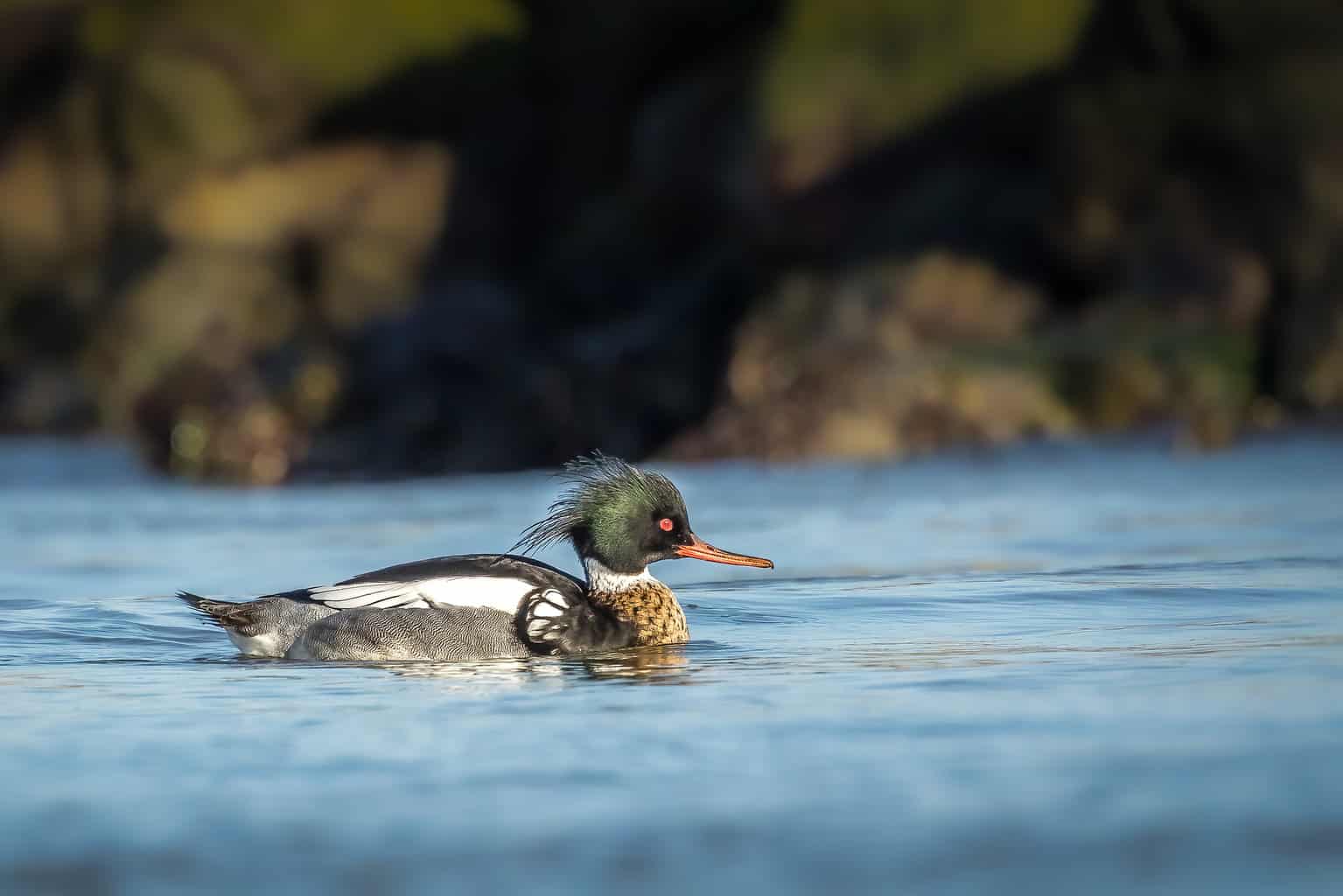
- Mergus serrator
- Length: 16 – 26 in (41 – 66 cm)
- Weight: 47.61 oz (1349 g)
- Wingspan: 31 – 35 in (79 – 89 cm)
Like other Mergansers, Red-Breasted Mergansers are crested. The male Red-Breasted Merganser’s crest is dark green, matching his equally dark green head.
He has a thick neck ring and a serrated orange bill. He is also marked in gray, black, white, and brown.
The female crest is cinnamon-brown. That means that the green-headed male and the brown-headed female have similar coloring as the Common Merganser.
Another similarity between the Red-Breasted and Common Merganser is their ability to tear apart their prey using their long, serrated bill.
Red-Breasted Mergansers are incredibly fast — up to 81 miles per hour in flight!
As sea ducks, Red-Breasted Mergansers aren’t motivated to stay in Kentucky for extended periods of time. They are found in migration in every state, but they only spend the winter on the coasts.
You’ll find these ducks in Kentucky in both the spring and fall as they move between inland Canada and the coastal waters of the US, Canada, and Mexico.
Redhead Duck (Diving Duck)
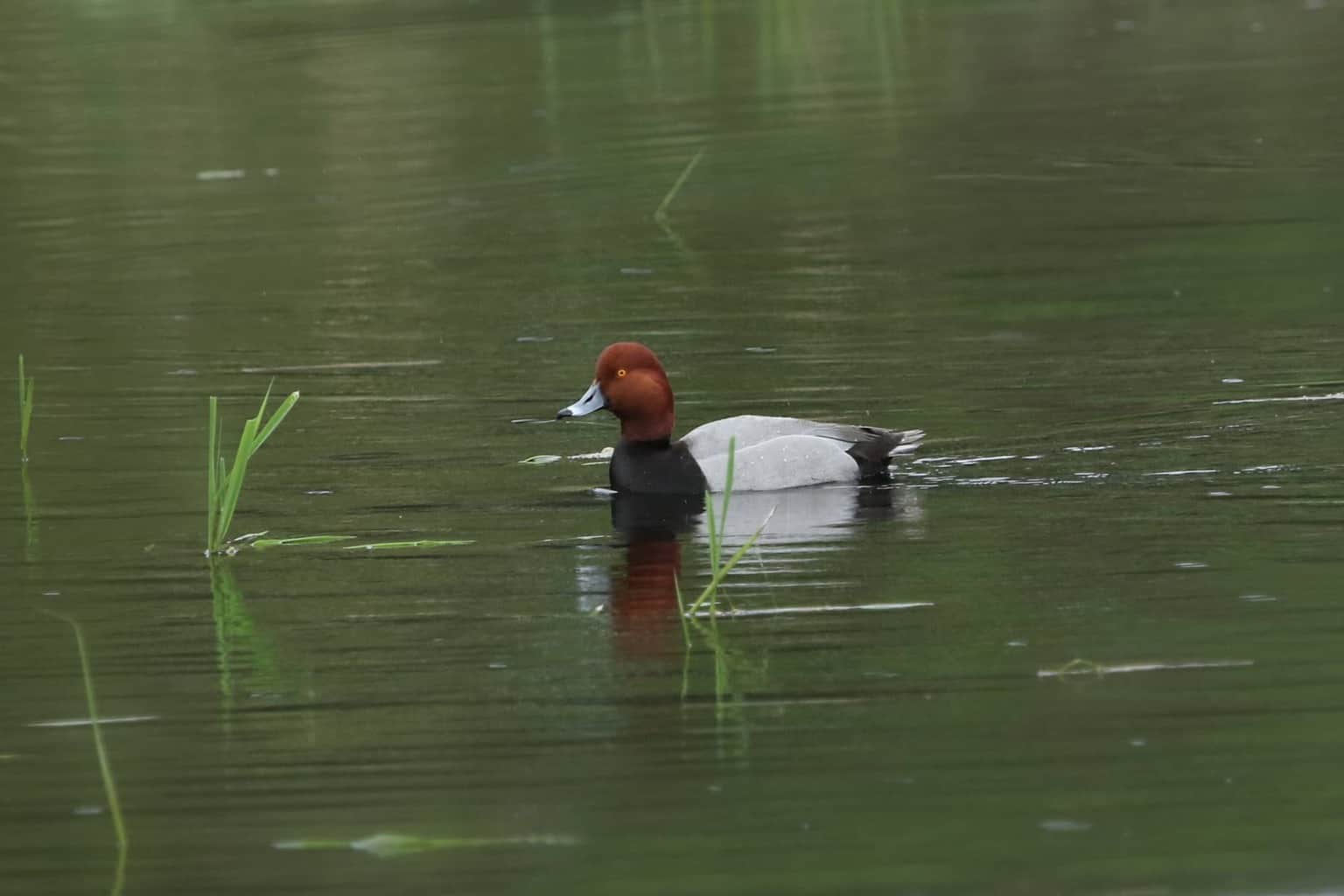
- Aythya americana
- Length: 18 -22 in (46 – 56 cm)
- Weight: 43.03 oz (1219 g)
- Wingspan: 29 – 35 in (74 – 89 cm)
It’s easy to figure out where the Redhead Duck gets his name. A male Redhead boasts a dark, deeply saturated coppery-brown head. His gray bill is tipped in black, and he has a black chest, gray sides, and a gray back.
Females lack distinctive markings and are quite plain in all brown. The female bill is also black-tipped.
As brood parasites, Redhead Ducks lay their eggs in other ducks’ nests, improving their overall reproductive success.
It’s possible that the conditions of their habitat play a role here, as they might be more likely to parasitize other nests if food is scarce and they know they will struggle to feed themselves and raise ducklings.
You will find Redhead Ducks in western Kentucky all winter, and in eastern Kentucky during their migratory windows.
Ring-Necked Duck (Diving Duck)
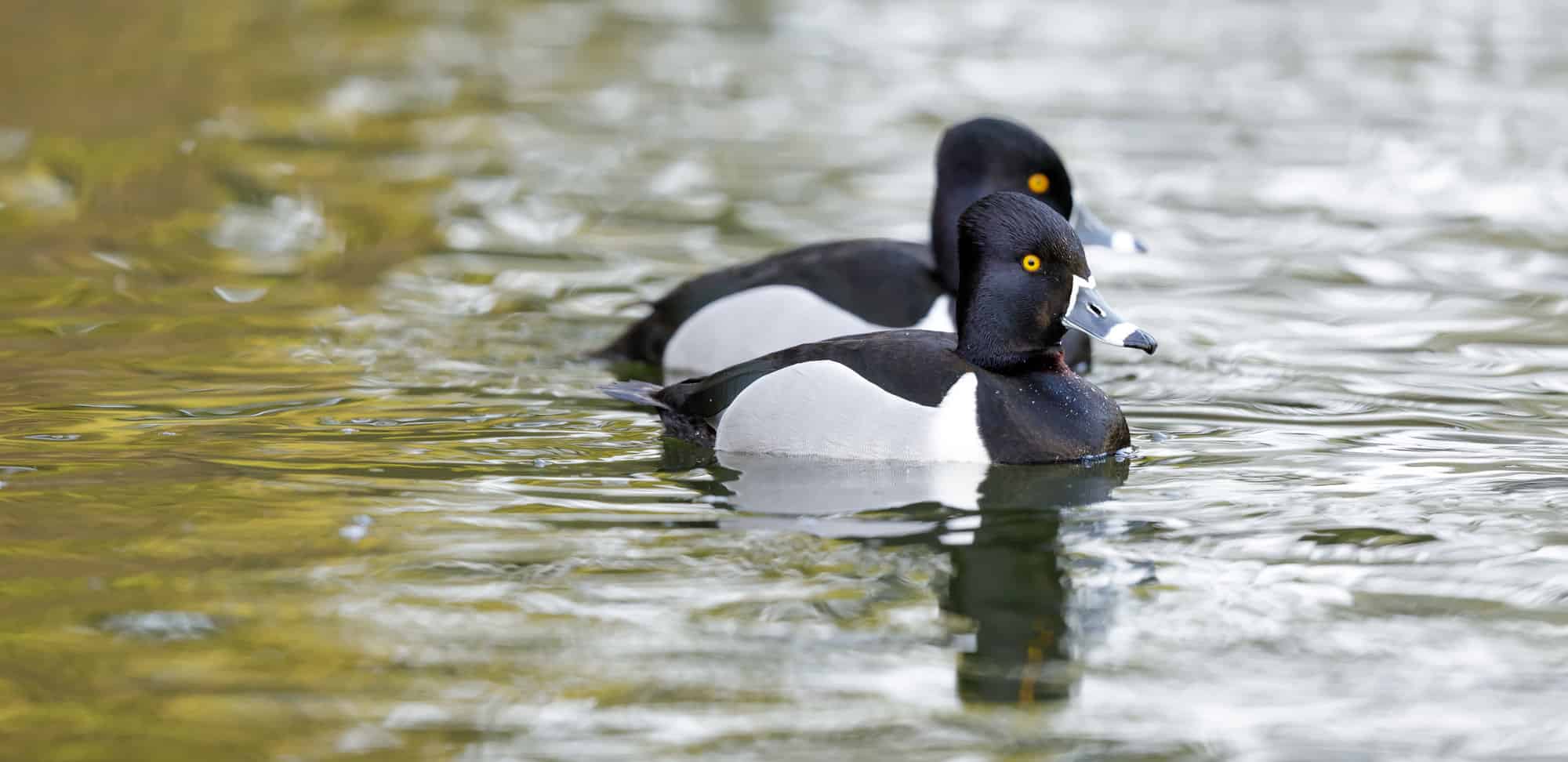
- Aythya collaris
- Length: 14 – 18 in (36 – 46 cm)
- Weight: 32.09 oz (909 g)
- Wingspan: 24 – 30 in (61 – 76 cm)
If there were ever a poorly named duck, it would be the Ring-Necked Duck. You’d think would be an obvious ring around the Ring-Necked Duck’s neck, right?
Well, the copper ring around the Ring-Necked Duck’s even darker neck is barely visible, even up close. From a distance, you won’t be able to see it at all.
Instead, try to remember that both male and female Ring-Necked Ducks have a thick white band that encircles their bill, near the tip.
Additionally, male Ring-Necked Ducks have a thin white ring that traces the base of their bill.
Aside from these markings, males are mostly black with gray sides.
Ring-Necked Ducks are winter residents of western Kentucky and along the northern border with Indiana. However, once you get as far east as Lexington, they are really only seen during their migration periods.
Ruddy Duck (Diving Duck)
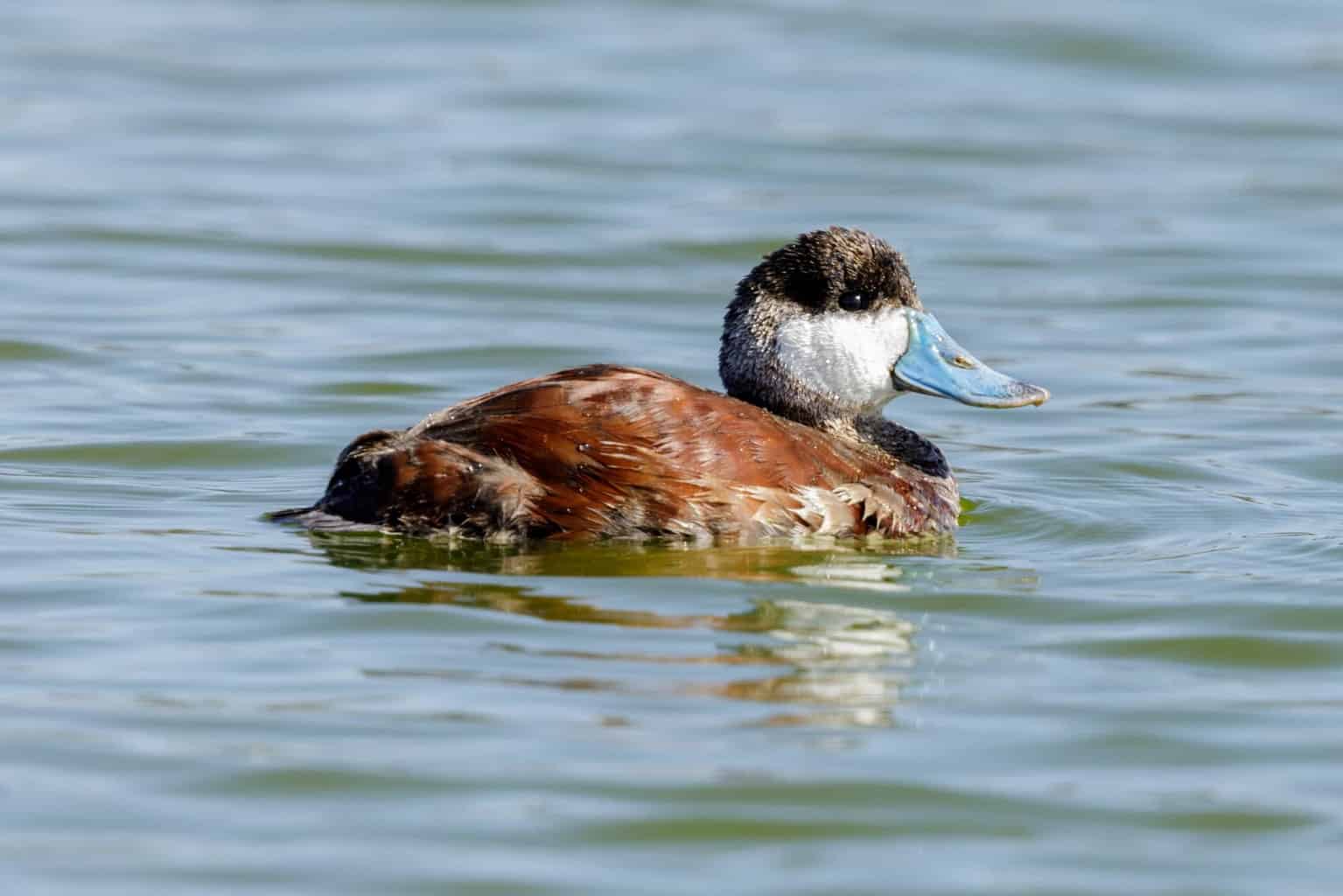
- Oxyura jamaicensis
- Length: 14 – 16 in (35.56 – 40.64 cm)
- Weight: 28.04 oz (795 g)
- Wingspan: 21 – 24 in (53 – 61 cm)
The appearance of a Ruddy Duck changes dramatically from summer to fall. In the summer, the male Ruddy Duck is covered with dark brown feathers. He has a black head with a large white patch on the cheeks, and a light blue bill.
Then, come fall, their molt leaves them with an overall dull gray appearance.
Females are dappled in brown. They have a gray cheek patch (instead of white), and their bill is black.
Ruddy Ducks tend to be quite comfortable around people, and they aren’t as skittish as many other species. That means you may be able to get close enough to capture a great picture.
After they were introduced to Europe as domesticated, captive ducks in the 1930s and 1940s, Ruddy Ducks have since become an invasive species. They began to escape — and thrive! — in the UK in the 1950s.
This is a problem because Ruddy Ducks outcompete and interbreed with the European native White-Headed Duck. They create an existential threat to these other ducks!
Because of this, Ruddy Ducks are treated quite differently in Europe.
In Kentucky, Ruddy Ducks are ordinary and inconsequential, but in parts of Europe, there are active campaigns to eradicate them.
Surf Scoter (Diving Duck)
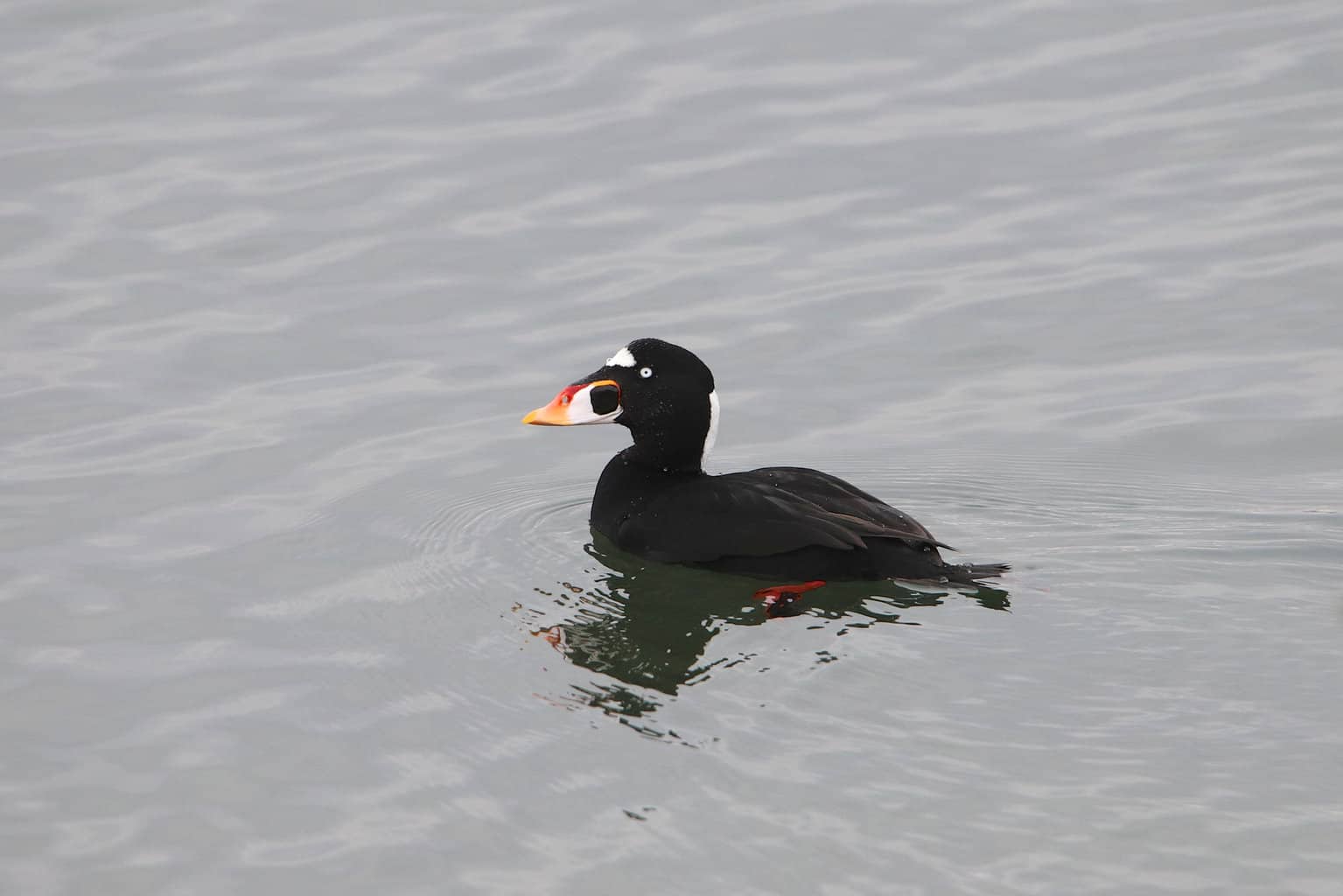
- Melanitta perspicillata
- Length: 17 – 21 in (43 – 53 cm)
- Weight: 35.27 oz (1000 g)
- Wingspan: 30 – 36 in (76 – 91 cm)
All scoters have interesting and unusually shaped bills, but the Surf Scoter’s bill is the most colorful in orange, red, and yellow.
He is black-bodied and has white spots on the base of his neck and right above the base of his bill.
Females have a gray bill, rather than a brightly colored one. They have a white patch on the back of their neck and behind each eye.
Surf Scoters are rarely seen in Kentucky, but eBird documents a number of sightings over the last several years. They are considered accidental migrants, as opposed to regular migrants.
Their breeding territory includes most of northern Canada and Alaska, whereas they spend the winter in North American coastal waters.
White-Winged Scoter (Sea Duck)
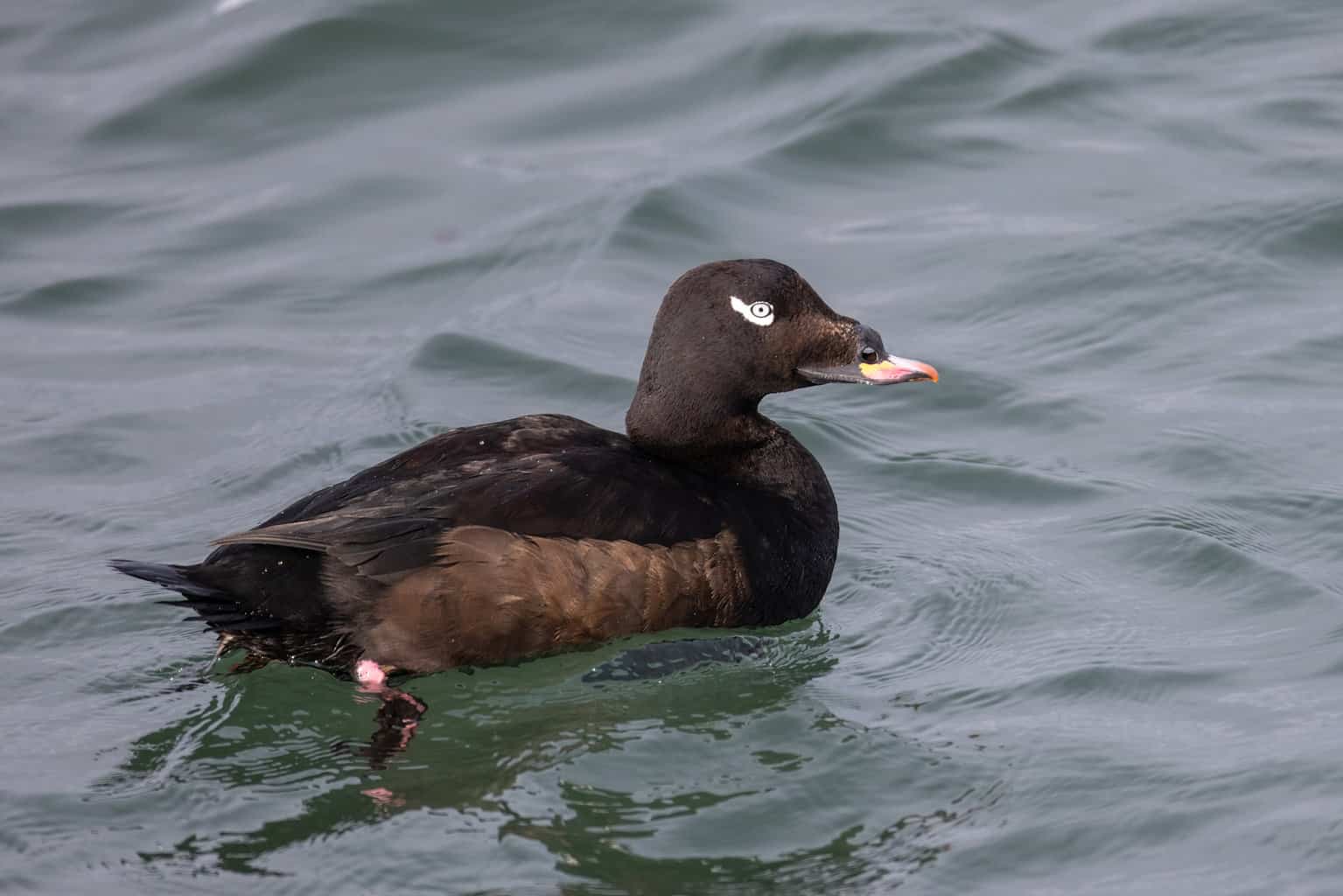
- Melanitta deglandi
- Length: 19 – 24 in (48 – 61 cm)
- Weight: 62.4 oz (1768 g)
- Wingspan: 33 – 41 in (84 – 104 cm)
White-Winged Scoters rarely go inland from their preferred coastal waters.
Like other scoters, White-Winged Scoters have that unusually shaped bill: tall at the base and smaller at the tip. The base of their bill is black, but the tip is orangish-red.
Males are black with an easily-spotted white marking on their face. It looks like a comma, right over each eye. They also have a long white stripe on their wings.
Females look similar, but their coloring is lighter. Instead of a comma over their eyes, they have a small white cheek patch.
Considering the fact that White-Winged Scoters rarely leave the coasts, how do they end up in Kentucky?
According to eBird, they aren’t so common to be considered regular migratory visitors in most of the US, but they are occasionally found on large, inland lakes while they migrate. This includes lakes in Kentucky.
You can review the individual sightings of the White-Winged Scoter on their eBird profile.
Wood Duck (Dabbling Duck)
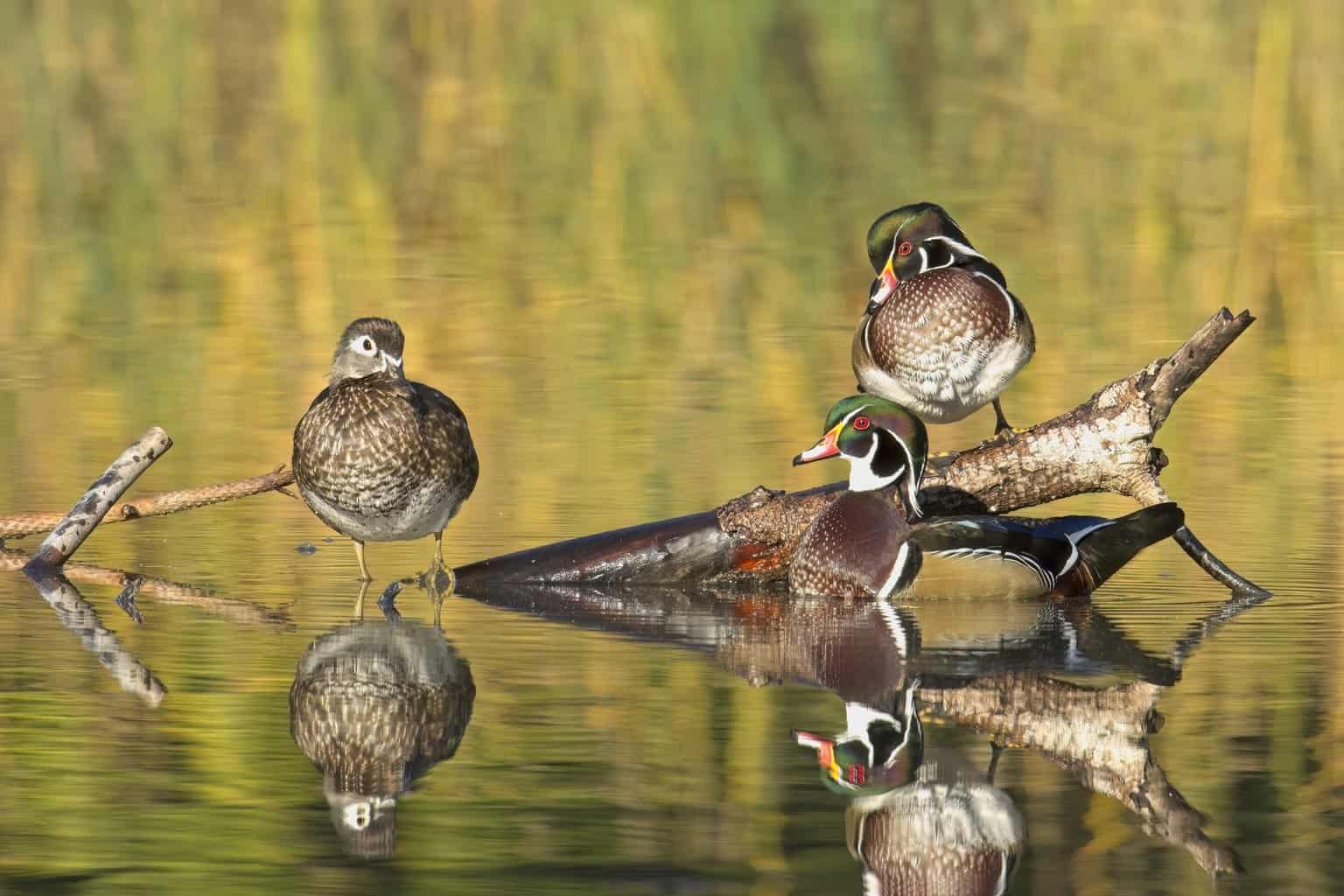
- Aix sponsa
- Length: 18.5 – 21.3 in (47 – 54 cm)
- Weight: 16.0 – 30.4 oz (454 – 862 g)
- Wingspan: 26.0 – 28.7 in (66 – 73 cm)
Wood Ducks are gorgeous! The male has a chestnut brown breast, dappled in pale beige. His head is iridescent green and has a long, angular crest at the back. He has white stripes on most of his body, and his bill is multi-colored in black, orange, white, and yellow.
Females, however, are less colorful. They have a small crest, brown body, and brown head. Their most colorful trait is the pretty blue, white, and purple coloring on their wings.
Wood Ducks are one of the easiest ducks to spot in Kentucky, as they live throughout the whole state, not just on the eastern edge. Plus, they are here year-round!
Wood Ducks prefer a wetland habitat that is also richly wooded, which gives them plenty of places to nest, hide, forage, and eat.
Spotting Ducks in Kentucky
Learning to find and identify ducks in Kentucky is a fun and rewarding hobby. After learning to identify some of the ducks you see out and about, you may decide that you want to turn this into a real pursuit!
Whether you live in Kentucky or are just a visitor, you have a good chance of seeing some interesting ducks in the state — especially in the winter! If you live in the Jackson Purchase area, your winter could be spent finding and identifying numerous kinds of ducks.
Of course, ducks aren’t the only special birds in Kentucky. Check out our Wild Bird Scoop guide to Birds in Kentucky to find out even more interesting species of birds you can see here.
Have fun!

